Turkey
Turkey (Turkish: Türkiye [ˈtyɾcije]), officially the Republic of Turkey (Turkish: Türkiye Cumhuriyeti [ˈtyɾcije dʒumˈhuːɾijeti] (![]() listen)), is a transcontinental country located mainly on the Anatolian Peninsula in Western Asia, with a small portion on the Balkan Peninsula in Southeast Europe. It shares borders with the Black Sea to the north; Georgia to the northeast; Armenia, Azerbaijan, and Iran to the east; Iraq to the southeast; Syria and the Mediterranean Sea to the south; the Aegean Sea to the west; and Greece and Bulgaria to the northwest. Cyprus is located off the south coast. Turks form the vast majority of the nation's population and Kurds are the largest minority.[4] Ankara is Turkey's capital, while Istanbul is its largest city and financial centre.
listen)), is a transcontinental country located mainly on the Anatolian Peninsula in Western Asia, with a small portion on the Balkan Peninsula in Southeast Europe. It shares borders with the Black Sea to the north; Georgia to the northeast; Armenia, Azerbaijan, and Iran to the east; Iraq to the southeast; Syria and the Mediterranean Sea to the south; the Aegean Sea to the west; and Greece and Bulgaria to the northwest. Cyprus is located off the south coast. Turks form the vast majority of the nation's population and Kurds are the largest minority.[4] Ankara is Turkey's capital, while Istanbul is its largest city and financial centre.
Republic of Turkey | |
|---|---|
 | |
| Anthem: İstiklal Marşı (Turkish) "The Independence March" | |
.svg.png.webp) | |
| Capital | Ankara 39°N 35°E |
| Largest city | Istanbul 41°1′N 28°57′E |
| Official languages | Turkish[1][2] |
| Spoken languages[3] |
|
| Other languages | |
| Ethnic groups (2016)[4] | |
| Religion | See Religion in Turkey |
| Demonym(s) |
|
| Government | Unitary presidential constitutional republic |
• President | Recep Tayyip Erdoğan |
• Vice President | Fuat Oktay |
• Assembly Speaker | Mustafa Şentop |
| Legislature | Grand National Assembly |
| Establishment | |
| c. 1299 | |
| 19 May 1919 | |
• Government of the Grand National Assembly | 23 April 1920 |
| 24 July 1923 | |
| 29 October 1923 | |
• Current constitution | 9 November 1982[5] |
| Area | |
• Total | 783,356 km2 (302,455 sq mi) (36th) |
• Water (%) | 2.03 (as of 2015)[6] |
| Population | |
• 2022 estimate | 84,680,273[7] (18th) |
• Density | 110[8]/km2 (284.9/sq mi) (107th) |
| GDP (PPP) | 2022 estimate |
• Total | |
• Per capita | |
| GDP (nominal) | 2022 estimate |
• Total | |
• Per capita | |
| Gini (2019) | medium |
| HDI (2021) | very high · 48th |
| Currency | Turkish lira (₺) (TRY) |
| Time zone | UTC+3 (TRT) |
| Date format | dd.mm.yyyy (CE) |
| Driving side | right |
| Calling code | +90 |
| ISO 3166 code | TR |
| Internet TLD | .tr |
One of the world's earliest permanently settled regions, present-day Turkey was home to important Neolithic sites like Göbekli Tepe, and was inhabited by ancient civilisations including the Hattians, Hittites, Anatolian peoples, Mycenaean Greeks, Persians and others.[12][13][14][15] Following the conquests of Alexander the Great which started the Hellenistic period, most of the ancient regions in modern Turkey were culturally Hellenised, which continued during the Byzantine era.[13][16] The Seljuk Turks began migrating in the 11th century, and the Sultanate of Rum ruled Anatolia until the Mongol invasion in 1243, when it disintegrated into small Turkish principalities.[17] Beginning in the late 13th century, the Ottomans united the principalities and conquered the Balkans, and the Turkification of Anatolia increased during the Ottoman period. After Mehmed II conquered Constantinople (Istanbul) in 1453, Ottoman expansion continued under Selim I. During the reign of Suleiman the Magnificent, the Ottoman Empire became a global power.[12][18][19] From the late 18th century onwards, the empire's power declined with a gradual loss of territories.[20] Mahmud II started a period of modernisation in the early 19th century.[21] The Young Turk Revolution of 1908 restricted the authority of the Sultan and restored the Ottoman Parliament after a 30-year suspension, ushering the empire into a multi-party period.[22][23] The 1913 coup d'état put the country under the control of the Three Pashas, who facilitated the Empire's entry into World War I as part of the Central Powers in 1914. During the war, the Ottoman government committed genocides against its Armenian, Greek and Assyrian subjects.[lower-alpha 1][26] After its defeat in the war, the Ottoman Empire was partitioned.[27]
The Turkish War of Independence against the occupying Allied Powers resulted in the abolition of the Sultanate on 1 November 1922, the signing of the Treaty of Lausanne (which superseded the Treaty of Sèvres) on 24 July 1923 and the proclamation of the Republic on 29 October 1923. With the reforms initiated by the country's first president, Mustafa Kemal Atatürk, Turkey became a secular, unitary and parliamentary republic. Turkey played a prominent role in the Korean War and joined NATO in 1952. The country endured several military coups in the latter half of the 20th century. The economy was liberalised in the 1980s, leading to stronger economic growth and political stability. The parliamentary republic was replaced with a presidential system by referendum in 2017.
Turkey is a regional power and a newly industrialized country,[28] with a geopolitically strategic location.[29] Its economy, which is classified among the emerging and growth-leading economies, is the twentieth-largest in the world by nominal GDP, and the eleventh-largest by PPP. In addition to being an early member of NATO, Turkey is a charter member of the United Nations, the IMF, and the World Bank, and a founding member of the OECD, OSCE, BSEC, OIC, OTS and G20. After becoming one of the early members of the Council of Europe in 1950, Turkey became an associate member of the EEC in 1963, joined the EU Customs Union in 1995, and started accession negotiations with the European Union in 2005. Turkey has a rich cultural legacy shaped by centuries of history and the influence of the various peoples that have inhabited its territory over several millennia; it is home to 19 UNESCO World Heritage Sites and is among the most visited countries in the world.
Name
The English name of Turkey (from Medieval Latin Turchia/Turquia[30]) means "land of the Turks". Middle English usage of Turkye is evidenced in an early work by Chaucer called The Book of the Duchess (c. 1369). The phrase land of Torke is used in the 15th-century Digby Mysteries. Later usages can be found in the Dunbar poems, the 16th century Manipulus Vocabulorum (Turkie) and Francis Bacon's Sylva Sylvarum (Turky). The modern spelling Turkey dates back to at least 1719.[31]
The name of Turkey appeared in the Western sources after the crusades.[32] In the 14th-century Arab sources, turkiyya is usually contrasted with turkmaniyya (Turkomania), probably to be understood as Oghuz in a broad sense.[33] Ibn Battuta, in the 1330s introduces the region as barr al-Turkiyya al-ma'ruf bi-bilad al-Rum ("the Turkish land known as the lands of Rum").[34] The disintegration of the country after World War I revived Turkish nationalism, and the Türkler için Türkiye ("Turkey for the Turks") sentiment rose up. With the Treaty of Alexandropol signed by the Government of the Grand National Assembly with Armenia, the name of Türkiye entered international documents for the first time. In the treaty signed with Afghanistan, the expression Devlet-i Aliyye-i Türkiyye ("Sublime Turkish State") was used, likened to the Ottoman Empire's name.[32]
Official name change
In January 2020, the Turkish Exporters' Assembly (TİM) — the umbrella organisation of Turkish exports — announced that it would use "Made in Turkiye" on all its labels in a bid to standardise branding and the identity of Turkish businesses on the international stage, using the term 'Turkiye' across all languages around the world.[35]
In December 2021, President Recep Tayyip Erdoğan issued a circular calling for exports to be labelled "Made in Türkiye". The circular also stated that in relation to other governmental communications "necessary sensitivity will be shown on the use of the phrase 'Türkiye' instead of phrases such as 'Turkey', 'Türkei', 'Turquie' etc."[36][37] The reason given in the circular for preferring Türkiye was that it "represents and expresses the culture, civilisation, and values of the Turkish nation in the best way". According to Turkish state broadcaster TRT World, it was also to avoid a pejorative association with turkey, the bird.[35] It was reported in January 2022 that the government planned to register Türkiye with the United Nations.[38] Minister of Foreign Affairs Mevlüt Çavuşoğlu sent letters to the UN and other international organisations on 31 May 2022 requesting that they use Türkiye. The UN agreed and implemented the request immediately.[39][40]
History
Prehistory of Anatolia and Eastern Thrace
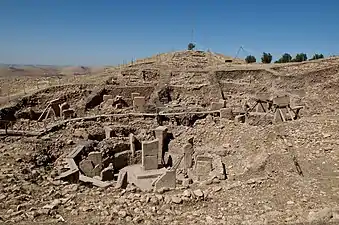
The Anatolian peninsula, comprising most of modern Turkey, is one of the oldest permanently settled regions in the world. Various ancient Anatolian populations have lived in Anatolia, from at least the Neolithic until the Hellenistic period.[13] Many of these peoples spoke the Anatolian languages, a branch of the larger Indo-European language family:[42] and, given the antiquity of the Indo-European Hittite and Luwian languages, some scholars have proposed Anatolia as the hypothetical centre from which the Indo-European languages radiated.[43] The European part of Turkey, called Eastern Thrace, has also been inhabited since at least forty thousand years ago, and is known to have been in the Neolithic era by about 6000 BC.[14]
Göbekli Tepe is the site of the oldest known man-made religious structure, a temple dating to circa 10,000 BC,[41] while Çatalhöyük is a very large Neolithic and Chalcolithic settlement in southern Anatolia, which existed from approximately 7500 BC to 5700 BC. It is the largest and best-preserved Neolithic site found to date and is a UNESCO World Heritage Site.[44] Nevalı Çori was an early Neolithic settlement on the middle Euphrates, in Şanlıurfa. Urfa Man statue is dated c. 9000 BC to the period of the Pre-Pottery Neolithic, and is considered as "the oldest naturalistic life-sized sculpture of a human".[45] It is considered as contemporaneous with the sites of Göbekli Tepe. The settlement of Troy started in the Neolithic Age and continued into the Iron Age.[46]
The earliest recorded inhabitants of Anatolia were the Hattians and Hurrians, non-Indo-European peoples who inhabited central and eastern Anatolia, respectively, as early as c. 2300 BC. Indo-European Hittites came to Anatolia and gradually absorbed the Hattians and Hurrians c. 2000–1700 BC. The first major empire in the area was founded by the Hittites, from the 18th through the 13th century BC. The Assyrians conquered and settled parts of southeastern Turkey as early as 1950 BC until the year 612 BC,[47] although they have remained a minority in the region, namely in Hakkari, Şırnak and Mardin.[48]
Urartu re-emerged in Assyrian inscriptions in the 9th century BC as a powerful northern rival of Assyria.[49] Following the collapse of the Hittite empire c. 1180 BC, the Phrygians, an Indo-European people, achieved ascendancy in Anatolia until their kingdom was destroyed by the Cimmerians in the 7th century BC.[50] Starting from 714 BC, Urartu shared the same fate and dissolved in 590 BC,[51] when it was conquered by the Medes. The most powerful of Phrygia's successor states were Lydia, Caria and Lycia.
Sardis was an ancient city at the location of modern Sart in Western Turkey. The city served as the capital of the ancient kingdom of Lydia. As one of the seven churches of Asia, it was addressed in the Book of Revelation in the New Testament,[52] The Lydian Lion coins were made of electrum, a naturally occurring alloy of gold and silver but of variable precious metal value. During the reign of King Croesus that the metallurgists of Sardis discovered the secret of separating gold from silver, thereby producing both metals of a purity never known before.[53]
Antiquity
Starting around 1200 BC, the coast of Anatolia was heavily settled by Aeolian and Ionian Greeks. Numerous important cities were founded by these colonists, such as Didyma, Miletus, Ephesus, Smyrna (now İzmir) and Byzantium (now Istanbul), the latter founded by Greek colonists from Megara in 657 BC.[54] Some of the most prominent pre-Socratic philosophers lived in the city of Miletus. Thales of Miletus (c. 624 BC – c. 546 BC) considered as first philosopher in the Greek tradition.[55][56] and he is otherwise historically recognized as the first individual known to have entertained and engaged in scientific philosophy.[57][58] In Miletus, he is followed by two other significant pre-Socratic philosophers Anaximander (c. 610 BC – c. 546 BC) and Anaximenes (c. 585 BC – c. 525 BC) (known collectively, to modern scholars, as the Milesian school).
For several centuries prior to the great Persian invasion of Greece, perhaps the very greatest and wealthiest city of the Greek world was Miletus, which founded more colonies than any other Greek city,[59] particularly in the Black Sea region. Diogenes the Cynic was one of the founders of Cynic philosophy born in one of the Ionian colonies Sinope on the Black Sea coast of Anatolia in 412.[60]

Trojan War took place in the ancient city of Troy by the Achaeans (Greeks) after Paris of Troy took Helen from her husband Menelaus, king of Sparta. The war is one of the most important events in Greek mythology and has been narrated through many works of Greek literature, most notably Homer's Iliad. Whether there is any historical reality behind the Trojan War remains an open question. Those who believe that the stories of the Trojan War are derived from a specific historical conflict usually date it to the 12th or 11th century BC, often preferring the dates given by Eratosthenes, 1194–1184 BC, which roughly correspond to archaeological evidence of a catastrophic burning of Troy VII,[64] and the Late Bronze Age collapse.
The first state that was called Armenia by neighbouring peoples was the state of the Armenian Orontid dynasty, which included parts of what is now eastern Turkey beginning in the 6th century BC. In Northwest Turkey, the most significant tribal group in Thrace was the Odyrisians, founded by Teres I.[65]
All of modern-day Turkey was conquered by the Persian Achaemenid Empire during the 6th century BC.[66] The Greco-Persian Wars started when the Greek city states on the coast of Anatolia rebelled against Persian rule in 499 BC.
Artemisia I of Caria was a queen of the ancient Greek city-state of Halicarnassus and she fought as an ally of Xerxes I, King of Persia against the independent Greek city states during the second Persian invasion of Greece in 480 BC.[67][68]
The territory of Turkey later fell to Alexander the Great in 334 BC,[69] which led to increasing cultural homogeneity and Hellenization in the area.[13] Following Alexander's death in 323 BC, Anatolia was subsequently divided into a number of small Hellenistic kingdoms, all of which became part of the Roman Republic by the mid-1st century BC.[70] The process of Hellenization that began with Alexander's conquest accelerated under Roman rule, and by the early centuries of the Christian Era, the local Anatolian languages and cultures had become extinct, being largely replaced by ancient Greek language and culture.[16][71] From the 1st century BC up to the 3rd century AD, large parts of modern-day Turkey were contested between the Romans and neighbouring Parthians through the frequent Roman-Parthian Wars.
Galatia was an ancient area in the highlands of central Anatolia inhabited by the Celts. The terms "Galatians" came to be used by the Greeks for the three Celtic peoples of Anatolia: the Tectosages, the Trocmii, and the Tolistobogii.[72][73] By the 1st century BC the Celts had become so Hellenized that some Greek writers called them Hellenogalatai (Ἑλληνογαλάται).[74] Galatia was named after the Gauls from Thrace (cf. Tylis), who settled here and became a small transient foreign tribe in the 3rd century BC, following the supposed Gallic invasion of the Balkans in 279 BC.
Kingdom of Pontus was a Hellenistic kingdom, centered in the historical region of Pontus and ruled by the Mithridatic dynasty of Persian origin,[75][76][77][78] which may have been directly related to Darius the Great and the Achaemenid dynasty.[79][78] The kingdom was proclaimed by Mithridates I in 281 BC and lasted until its conquest by the Roman Republic in 63 BC. The Kingdom of Pontus reached its largest extent under Mithridates VI the Great, who conquered Colchis, Cappadocia, Bithynia, the Greek colonies of the Tauric Chersonesos. After a long struggle with Rome in the Mithridatic Wars, Pontus was defeated.
All territories corresponding to modern Turkey eventually fell into Roman Empire’s control.
Early Christian and Roman period
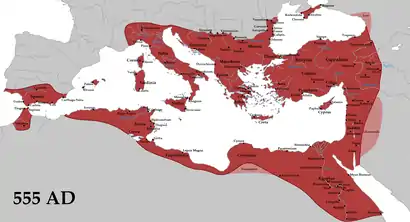
.jpg.webp)
According to the Acts of Apostles,[81] Antioch (now Antakya), a city in southern Turkey, is where followers of Jesus were first called "Christians" and became very quickly an important center of Christianity.[82][83] Paul the Apostle traveled to Ephesus and stayed there for almost three years, probably working there as a tentmaker.[84] He is claimed to have performed numerous miracles, healing people and casting out demons, and he apparently organized missionary activity in other regions.[85] Paul left Ephesus after an attack from a local silversmith resulted in a pro-Artemis riot involving most of the city.[85]
In the year 123, Emperor Hadrian traveled to Anatolia. Numerous monuments were erected for his arrival and he met his lover Antinous from Bithynia.[86] Hadrian focused on the Greek revival and built several temples and improved the cities. Cyzicus, Pergamon, Smyrna, Ephesus and Sardes were promoted as regional centres for the Imperial cult (neocoros) during this period.[87]
Byzantine period
In 324 AD, Constantine I chose Byzantium to be the new capital of the Roman Empire, renaming it New Rome. Under Constantine, Christianity did not become the exclusive religion of the state, but enjoyed imperial preference since he supported it with generous privileges. Following the death of Theodosius I in 395 and the permanent division of the Roman Empire between his two sons, the city, which would popularly come to be known as Constantinople, became the capital of the Eastern Roman Empire. This empire, which would later be branded by historians as the Byzantine Empire, ruled most of the territory of present-day Turkey until the Late Middle Ages;[88] although the eastern regions remained firmly in Sasanian hands until the first half of the 7th century. The frequent Byzantine-Sassanid Wars, a continuation of the centuries-long Roman-Persian Wars, took place in various parts of present-day Turkey between the 4th and 7th centuries. Several ecumenical councils of the early Church were held in cities located in present-day Turkey, including the First Council of Nicaea (Iznik) in 325, the First Council of Constantinople (Istanbul) in 381, the Council of Ephesus in 431, and the Council of Chalcedon (Kadıköy) in 451.[89] During most of its existence, the Byzantine Empire was one of the most powerful economic, cultural, and military forces in Europe.[90]
Seljuks and the Ottoman Empire
The House of Seljuk originated from the Kınık branch of the Oghuz Turks who resided on the periphery of the Muslim world, in the Yabgu Khaganate of the Oğuz confederacy, to the north of the Caspian and Aral Seas, in the 9th century.[91] In the 10th century, the Seljuks started migrating from their ancestral homeland into Persia, which became the administrative core of the Great Seljuk Empire, after its foundation by Tughril.[92]

In the latter half of the 11th century, the Seljuk Turks began penetrating into medieval Armenia and the eastern regions of Anatolia. In 1071, the Seljuks defeated the Byzantines at the Battle of Manzikert, starting the Turkification process in the area; the Turkish language and Islam were introduced to Anatolia, gradually spreading throughout the region. The slow transition from a predominantly Christian and Greek-speaking Anatolia to a predominantly Muslim and Turkish-speaking one was underway. The Mevlevi Order of dervishes, which was established in Konya during the 13th century by Sufi poet Celaleddin Rumi, played a significant role in the Islamization of the diverse people of Anatolia who had previously been Hellenized.[94][95] Thus, alongside the Turkification of the territory, the culturally Persianized Seljuks set the basis for a Turko-Persian principal culture in Anatolia,[96] which their eventual successors, the Ottomans, would take over.[97][98] In 1243, the Seljuk armies were defeated by the Mongols at the Battle of Köse Dağ, causing the Seljuk Empire's power to slowly disintegrate. In its wake, one of the Turkish principalities governed by Osman I would evolve over the next 200 years into the Ottoman Empire. The Ottomans completed their conquest of the Byzantine Empire by capturing its capital, Constantinople, in 1453: their commander thenceforth being known as Mehmed the Conqueror.
In 1514, Sultan Selim I (1512–1520) successfully expanded the empire's southern and eastern borders by defeating Shah Ismail I of the Safavid dynasty in the Battle of Chaldiran. In 1517, Selim I expanded Ottoman rule into Algeria and Egypt, and created a naval presence in the Red Sea. Subsequently, a contest started between the Ottoman and Portuguese empires to become the dominant sea power in the Indian Ocean, with a number of naval battles in the Red Sea, the Arabian Sea and the Persian Gulf. The Portuguese presence in the Indian Ocean was perceived as a threat to the Ottoman monopoly over the ancient trade routes between East Asia and Western Europe. Despite the increasingly prominent European presence, the Ottoman Empire's trade with the east continued to flourish until the second half of the 18th century.[101]
The Ottoman Empire's power and prestige peaked in the 16th and 17th centuries, particularly during the reign of Suleiman the Magnificent, who personally instituted major legislative changes relating to society, education, taxation and criminal law.
The empire was often at odds with the Holy Roman Empire in its steady advance towards Central Europe through the Balkans and the southern part of the Polish–Lithuanian Commonwealth.[102]
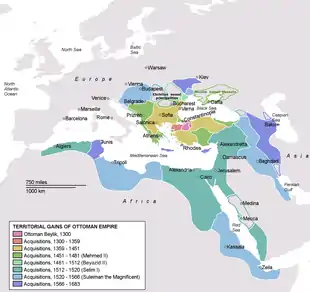
The Ottoman Navy contended with several Holy Leagues, such as those in 1538, 1571, 1684 and 1717 (composed primarily of Habsburg Spain, the Republic of Genoa, the Republic of Venice, the Knights of St. John, the Papal States, the Grand Duchy of Tuscany and the Duchy of Savoy), for the control of the Mediterranean Sea.
In the east, the Ottomans were often at war with Safavid Persia over conflicts stemming from territorial disputes or religious differences between the 16th and 18th centuries.[103] The Ottoman wars with Persia continued as the Zand, Afsharid, and Qajar dynasties succeeded the Safavids in Iran, until the first half of the 19th century.
Even further east, there was an extension of the Habsburg-Ottoman conflict, in that the Ottomans also had to send soldiers to their farthest and easternmost vassal and territory, the Aceh Sultanate[104][105] in Southeast Asia, to defend it from European colonizers as well as the Latino invaders who had crossed from Latin America and had Christianized the formerly Muslim-dominated Philippines.[106]
From the 16th to the early 20th centuries, the Ottoman Empire also fought twelve wars with the Russian Tsardom and Empire. These were initially about Ottoman territorial expansion and consolidation in southeastern and eastern Europe; but starting from the Russo-Turkish War (1768–1774), they became more about the survival of the Ottoman Empire, which had begun to lose its strategic territories on the northern Black Sea coast to the advancing Russians.
From the second half of the 18th century onwards, the Ottoman Empire began to decline. The Tanzimat reforms, initiated by Mahmud II just before his death in 1839, aimed to modernise the Ottoman state in line with the progress that had been made in Western Europe. The efforts of Midhat Pasha during the late Tanzimat era led the Ottoman constitutional movement of 1876, which introduced the First Constitutional Era, but these efforts proved to be inadequate in most fields, and failed to stop the dissolution of the empire.[107]
As the empire gradually shrank in size, military power and wealth; especially after the Ottoman economic crisis and default in 1875[108] which led to uprisings in the Balkan provinces that culminated in the Russo-Turkish War (1877–1878); many Balkan Muslims migrated to the Empire's heartland in Anatolia,[109][110] along with the Circassians fleeing the Russian conquest of the Caucasus. According to some estimates, up to 1.5 million Muslim Circassians died during the Circassian genocide, the survivors seek refugee in Ottoman Empire. The decline of the Ottoman Empire led to a rise in nationalist sentiment among its various subject peoples, leading to increased ethnic tensions which occasionally burst into violence, such as the Hamidian massacres of Armenians, which claimed up to 300,000 lives.[111]
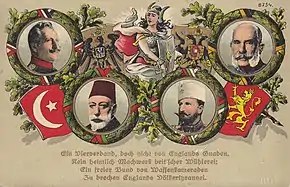
- Central Power Monarchs on a WWI Postcard:
- Kaiser Wilhelm II of Germany;
- Kaiser and King Franz Joseph of Austria-Hungary;
- Sultan Mehmed V of the Ottoman Empire;
- Tsar Ferdinand I of Bulgaria
The loss of Rumelia (Ottoman territories in Europe) with the First Balkan War (1912–1913) was followed by the arrival of millions of Muslim refugees (muhacir) to Istanbul and Anatolia.[112] Historically, the Rumelia Eyalet and Anatolia Eyalet had formed the administrative core of the Ottoman Empire, with their governors titled Beylerbeyi participating in the Sultan's Divan, so the loss of all Balkan provinces beyond the Midye-Enez border line according to the London Conference of 1912–13 and the Treaty of London (1913) was a major shock for the Ottoman society and led to the 1913 Ottoman coup d'état. In the Second Balkan War (1913) the Ottomans managed to recover their former capital Edirne (Adrianople) and its surrounding areas in East Thrace, which was formalised with the Treaty of Constantinople (1913). The 1913 coup d'état effectively put the country under the control of the Three Pashas, making sultans Mehmed V and Mehmed VI largely symbolic figureheads with no real political power.

The Ottoman Empire entered World War I on the side of the Central Powers and was ultimately defeated. The Ottomans successfully defended the Dardanelles strait during the Gallipoli campaign (1915–1916) and achieved initial victories against British forces in the first two years of the Mesopotamian campaign, such as the Siege of Kut (1915–1916); but the Arab Revolt (1916–1918) turned the tide against the Ottomans in the Middle East. In the Caucasus campaign, however, the Russian forces had the upper hand from the beginning, especially after the Battle of Sarikamish (1914–1915). Russian forces advanced into northeastern Anatolia and controlled the major cities there until retreating from World War I with the Treaty of Brest-Litovsk following the Russian Revolution (1917). During the war, the empire's Armenian subjects were deported to Syria as part of the Armenian genocide. As a result, an estimated 600,000[113] to more than 1 million,[113] or up to 1.5 million[114][115][116] Armenians were killed. The Turkish government has refused to acknowledge the events as genocide and states that Armenians were only "relocated" from the eastern war zone.[117] Genocidal campaigns were also committed against the empire's other minority groups such as the Assyrians and Greeks.[118][119][120] Following the Armistice of Mudros on 30 October 1918, the victorious Allied Powers sought to partition the Ottoman state through the 1920 Treaty of Sèvres.[121]
Republic of Turkey
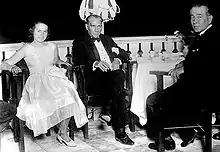
The occupation of Istanbul (1918) and İzmir (1919) by the Allies in the aftermath of World War I prompted the establishment of the Turkish National Movement. Under the leadership of Mustafa Kemal Pasha, a military commander who had distinguished himself during the Battle of Gallipoli, the Turkish War of Independence (1919–1923) was waged with the aim of revoking the terms of the Treaty of Sèvres (1920).[122]
By 18 September 1922 the Greek, Armenian and French armies had been expelled,[123] and the Turkish Provisional Government in Ankara, which had declared itself the legitimate government of the country on 23 April 1920, started to formalise the legal transition from the old Ottoman into the new Republican political system. On 1 November 1922, the Turkish Parliament in Ankara formally abolished the Sultanate, thus ending 623 years of monarchical Ottoman rule. The Treaty of Lausanne of 24 July 1923, which superseded the Treaty of Sèvres,[121][122] led to the international recognition of the sovereignty of the newly formed "Republic of Turkey" as the successor state of the Ottoman Empire, and the republic was officially proclaimed on 29 October 1923 in Ankara, the country's new capital.[124] The Lausanne Convention stipulated a population exchange between Greece and Turkey, whereby 1.1 million Greeks left Turkey for Greece in exchange for 380,000 Muslims transferred from Greece to Turkey.[125]
.jpg.webp)
Mustafa Kemal became the republic's first President and subsequently introduced many reforms. The reforms aimed to transform the old religion-based and multi-communal Ottoman constitutional monarchy into a Turkish nation state that would be governed as a parliamentary republic under a secular constitution.[127] With the Surname Law of 1934, the Turkish Parliament bestowed upon Mustafa Kemal the honorific surname "Atatürk" (Father Turk).[122]
The Montreux Convention (1936) restored Turkey's control over the Turkish Straits, including the right to militarise the coastlines of the Dardanelles and Bosporus straits and the Sea of Marmara, and to block maritime traffic in wartime.[128]
Following the establishment of the Republic of Turkey in 1923, some Kurdish and Zaza tribes, which were feudal (manorial) communities led by chieftains (agha) during the Ottoman period, became discontent about certain aspects of Atatürk's reforms aiming to modernise the country, such as secularism (the Sheikh Said rebellion, 1925)[129] and land reform (the Dersim rebellion, 1937–1938),[130] and staged armed revolts that were put down with military operations.
İsmet İnönü became Turkey's second President following Atatürk's death on 10 November 1938. On 29 June 1939, the Republic of Hatay voted in favour of joining Turkey with a referendum. Turkey remained neutral during most of World War II, but entered the closing stages of the war on the side of the Allies on 23 February 1945. On 26 June 1945, Turkey became a charter member of the United Nations.[131] In the following year, the one-party period in Turkey came to an end, with the first multi-party elections in 1946. In 1950 Turkey became a member of the Council of Europe.
The Democrat Party established by Celâl Bayar won the 1950, 1954 and 1957 general elections and stayed in power for a decade, with Adnan Menderes as the Prime Minister and Bayar as the President. After fighting as part of the United Nations forces in the Korean War, Turkey joined NATO in 1952, becoming a bulwark against Soviet expansion into the Mediterranean. Turkey subsequently became a founding member of the OECD in 1961, and an associate member of the EEC in 1963.[132]
The country's tumultuous transition to multi-party democracy was interrupted by military coups d'état in 1960 and 1980, as well as by military memorandums in 1971 and 1997.[133][134] Between 1960 and the end of the 20th century, the prominent leaders in Turkish politics who achieved multiple election victories were Süleyman Demirel, Bülent Ecevit and Turgut Özal. Tansu Çiller became the first female prime minister of Turkey in 1993.
Following a decade of Cypriot intercommunal violence and the coup in Cyprus on 15 July 1974 staged by the EOKA B paramilitary organisation, which overthrew President Makarios and installed the pro-Enosis (union with Greece) Nikos Sampson as dictator, Turkey invaded Cyprus on 20 July 1974 by unilaterally exercising Article IV in the Treaty of Guarantee (1960), but without restoring the status quo ante at the end of the military operation.[135] In 1983 the Turkish Republic of Northern Cyprus, which is recognised only by Turkey, was established.[136] The Annan Plan for reunifying the island was supported by the majority of Turkish Cypriots, but rejected by the majority of Greek Cypriots, in separate referendums in 2004. However, negotiations for solving the Cyprus dispute are still ongoing between Turkish Cypriot and Greek Cypriot political leaders.[137]
The conflict between Turkey and the Kurdistan Workers' Party (PKK) (designated a terrorist organisation by Turkey, the United States,[138] and the European Union[139]) has been active since 1984, primarily in the southeast of the country. More than 40,000 people have died as a result of the conflict.[140][141][142] In 1999 PKK's founder Abdullah Öcalan was arrested and sentenced for terrorism[138][139] and treason charges.[143][144] In the past, various Kurdish groups have unsuccessfully sought separation from Turkey to create an independent Kurdish state, while others have more recently pursued provincial autonomy and greater political and cultural rights for Kurds in Turkey. In the 21st century some reforms have taken place to improve the cultural rights of ethnic minorities in Turkey, such as the establishment of TRT Kurdî, TRT Arabi and TRT Avaz by the TRT.

Since the liberalisation of the Turkish economy in the 1980s, the country has enjoyed stronger economic growth and greater political stability.[145] Turkey applied for full membership of the EEC in 1987, joined the EU Customs Union in 1995 and started accession negotiations with the European Union in 2005.[146][147] In a non-binding vote on 13 March 2019, the European Parliament called on the EU governments to suspend EU accession talks with Turkey, citing violations of human rights and the rule of law; but the negotiations, effectively on hold since 2018, remain active as of 2020.[148]
In 2013, widespread protests erupted in many Turkish provinces, sparked by a plan to demolish Gezi Park but soon growing into general anti-government dissent.[149] On 15 July 2016, an unsuccessful coup attempt tried to oust the government.[150] As a reaction to the failed coup d'état, the government carried out mass purges,[151][152] jailed journalists, and shut down media outlets.[153]
Between 9 October and 25 November 2019, Turkey invaded north-eastern Syria.[154][155][156]
Administrative divisions
Turkey has a unitary structure in terms of administration and this aspect is one of the most important factors shaping the Turkish public administration. When three powers (executive, legislative and judiciary) are taken into account as the main functions of the state, local administrations have little power. Turkey does not have a federal system, and the provinces are subordinate to the central government in Ankara. Local administrations were established to provide services in place and the government is represented by the province governors (vali) and town governors (kaymakam). Other senior public officials are also appointed by the central government instead of the mayors (belediye başkanı) or elected by constituents.[157] Turkish municipalities have local legislative bodies (belediye meclisi) for decision-making on municipal issues.
Within this unitary framework, Turkey is subdivided into 81 provinces (il or vilayet) for administrative purposes. Each province is divided into districts (ilçe), for a total of 973 districts.[158] Turkey is also subdivided into 7 regions (bölge) and 21 subregions for geographic, demographic and economic purposes; this does not refer to an administrative division.
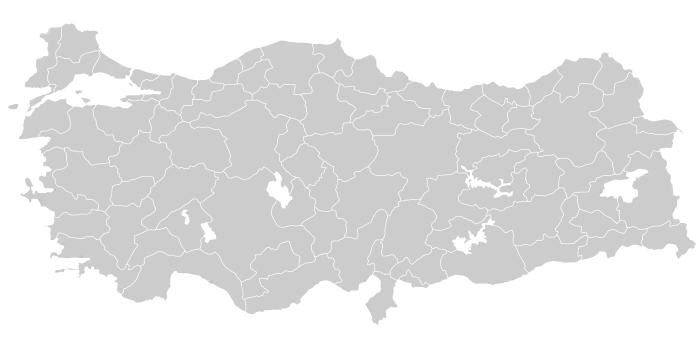
Government and politics

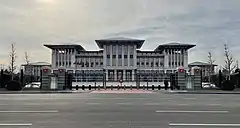
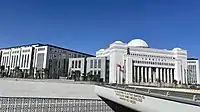
Turkey is a presidential republic within a multi-party system.[159] The current constitution was approved by referendum in 1982, which determines the government's structure, lays forth the ideals and standards of the state's conduct, and sets out the state's responsibility to its citizens. Furthermore, the constitution specifies the people's rights and obligations, as well as principles for the delegation and exercise of sovereignty that belongs to the people of Turkey.[160]
In the Turkish unitary system, citizens are subject to three levels of government: national, provincial, and local. The local government's duties are commonly split between municipal governments and districts, in which executive and legislative officials are elected by a plurality vote of citizens by district. Turkey is subdivided into 81 provinces for administrative purposes. Each province is divided into districts, for a total of 973 districts.
The government, regulated by a system of separation of powers as defined by the constitution of Turkey, comprises three branches:
- Legislative: The unicameral Parliament makes law, debates and adopts the budget bills, declares war, approves treaties, proclaims amnesty and pardon, and has the power of impeachment, by which it can remove sitting members of the government.[161]
- Executive: The president is the commander-in-chief of the military, can veto legislative bills before they become law (subject to parliamentary override), can issue presidential decrees on matters regarding executive power with exception of fundamental rights, individual rights and certain political rights (parliamentary laws prevail presidential decrees), and appoints the members of the Cabinet and other officers, who administer and enforce national laws and policies.[162]
- Judicial: The Constitutional Court (for constitutional adjudication and review of individual applications concerning human rights), the Court of Cassation (final decision maker in ordinary judiciary), the Council of State (final decision maker in administrative judiciary) and the Court of Jurisdictional Disputes (for resolving the disputes between courts for constitutional jurisdiction) are the four organizations that are described by the Constitution as supreme courts. The judges of the Constitutional Court are appointed by the president and the parliament.[5]
The Parliament has 600 voting members, each representing a constituency for a five-year term. Parliamentary seats are distributed among the provinces by population, conform with the census apportionment. The president is elected by direct vote and serves a five-year term. The president can't run for re-elections after two terms of five-years, unless parliament prematurely renews the presidential elections during the second term of the President. Elections for the Parliament and presidential elections are held on the same day. The Constitutional Court is composed of fifteen members. A member is elected for a term of twelve years and can't be reelected. The members of the Constitutional Court are obliged to retire when they are over the age of sixty-five.[163]
Parties and elections
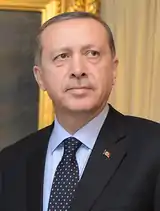
President
Elections in Turkey are held for six functions of government: presidential elections (national), parliamentary elections (national), municipality mayors (local), district mayors (local), provincial or municipal council members (local) and muhtars (local). Apart from elections, referendums are also held occasionally.
Every Turkish citizen who has turned 18 has the right to vote and stand as a candidate at elections. Universal suffrage for both sexes has been applied throughout Turkey since 1934 and before most countries. In Turkey, turnout rates of both local and general elections are high compared to many other countries, which usually stands higher than 80 percent.[164] There are 600 members of parliament who are elected for a five-year term by a party-list proportional representation system from 88 electoral districts. The Constitutional Court can strip the public financing of political parties that it deems anti-secular or having ties to terrorism, or ban their existence altogether.[165][166] The electoral threshold for political parties at national level is seven percent of the votes.[167] Smaller parties can avoid the electoral threshold by forming an alliance with other parties, in which it is sufficient that the total votes of the alliance passes 7%. Independent candidates are not subject to an electoral threshold.
After World War II, Turkey operated under a multi-party system. On the right side of the Turkish political spectrum, parties like Democrat Party (DP), Justice Party (AP), Motherland Party (ANAP) and Justice and Development Party (AKP) once became the largest political party in Turkey. Turkish right-wing parties are more likely to embrace principles of political ideologies such as conservatism, nationalism or Islamism.[168] On the left side of the spectrum, parties like Republican People's Party (CHP), Social Democratic Populist Party (SHP) and Democratic Left Party (DSP) once enjoyed the largest electoral success. Left-wing parties are more likely to embrace principles of socialism, Kemalism or secularism.[169]
The 12th President Recep Tayyip Erdoğan, the winner of the 2018 presidential election and former prime minister, is currently serving as the head of state and head of government. Kemal Kılıçdaroğlu is the main opposition leader of Turkey. Mustafa Şentop is the Speaker of the Grand National Assembly.
The 27th Parliament of Turkey was installed following the 2018 parliamentary election, with the starting composition of 295 seats for the Justice and Development Party (AKP), 146 seats for the Republican People's Party (CHP), 67 seats for the Peoples' Democratic Party (HDP), 49 seats for the Nationalist Movement Party (MHP) and 49 seats for the Good Party (İP).[170] The next parliamentary election is scheduled to take place in 2023.
Law
.jpg.webp)
With the founding of the Republic, Turkey adopted a civil law legal system, replacing Sharia-derived Ottoman law. The Civil Code, adopted in 1926, was based on the Swiss Civil Code of 1907 and the Swiss Code of Obligations of 1911. Although it underwent a number of changes in 2002, it retains much of the basis of the original Code. The Criminal Code, originally based on the Italian Criminal Code, was replaced in 2005 by a Code with principles similar to the German Penal Code and German law generally. Administrative law is based on the French equivalent and procedural law generally shows the influence of the Swiss, German and French legal systems.[171] Islamic principles do not play a part in the legal system.[172]
Turkey has adopted the principle of the separation of powers. In line with this principle, judicial power is exercised by independent courts on behalf of the Turkish nation. The independence and organisation of the courts, the security of the tenure of judges and public prosecutors, the profession of judges and prosecutors, the supervision of judges and public prosecutors, the military courts and their organisation, and the powers and duties of the high courts are regulated by the Turkish Constitution.[173]
According to Article 142 of the Turkish Constitution, the organisation, duties and jurisdiction of the courts, their functions and the trial procedures are regulated by law. In line with the aforementioned article of the Turkish Constitution and related laws, the court system in Turkey can be classified under three main categories; which are the Judicial Courts, Administrative Courts, and Military Courts. Each category includes first instance courts and high courts. In addition, the Court of Jurisdictional Disputes rules on cases that cannot be classified readily as falling within the purview of one court system.[173]
Law enforcement in Turkey is carried out by several agencies under the jurisdiction of the Ministry of Internal Affairs. These agencies are the General Directorate of Security, the Gendarmerie General Command and the Coast Guard Command. Furthermore, there are other law enforcement agencies with specific (National Intelligence Organization, General Directorate of Customs Protection, etc.) or local (Village guards, Municipal Police, etc.) assignments that are under the jurisdiction of the president or different ministries.
In the years of government by the AKP and Erdoğan, particularly since 2013, the independence and integrity of the Turkish judiciary has increasingly been said to be in doubt by institutions, parliamentarians and journalists both within and outside of Turkey; due to political interference in the promotion of judges and prosecutors, and in their pursuit of public duty.[174][175][176][177] The Turkey 2015 report of the European Commission stated that "the independence of the judiciary and respect of the principle of separation of powers have been undermined and judges and prosecutors have been under strong political pressure."[174]
Foreign relations
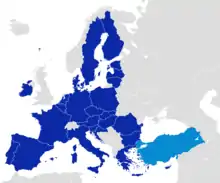
Turkey is a founding member of the United Nations (1945),[178] the OECD (1961),[179] the OIC (1969),[180] the OSCE (1973),[181] the ECO (1985),[182] the BSEC (1992),[183] the D-8 (1997)[184] and the G20 (1999).[185] Turkey was a member of the United Nations Security Council in 1951–1952, 1954–1955, 1961 and 2009–2010.[186] In 2012 Turkey became a dialogue partner of the SCO, and in 2013 became a member of the ACD.[187][188]
In line with its traditional Western orientation, relations with Europe have always been a central part of Turkish foreign policy. Turkey became one of the early members of the Council of Europe in 1950, applied for associate membership of the EEC (predecessor of the European Union) in 1959 and became an associate member in 1963. After decades of political negotiations, Turkey applied for full membership of the EEC in 1987, became an associate member of the Western European Union in 1992, joined the EU Customs Union in 1995 and has been in formal accession negotiations with the EU since 2005.[146][147] Turkey's support for Northern Cyprus in the Cyprus dispute complicates Turkey's relations with the EU and remains a major stumbling block to the country's EU accession bid.[189]
The other defining aspect of Turkey's foreign policy was the country's long-standing strategic alliance with the United States.[190][191] The Truman Doctrine in 1947 enunciated American intentions to guarantee the security of Turkey and Greece during the Cold War, and resulted in large-scale U.S. military and economic support. In 1948 both countries were included in the Marshall Plan and the OEEC for rebuilding European economies.[192] The common threat posed by the Soviet Union during the Cold War led to Turkey's membership of NATO in 1952, ensuring close bilateral relations with the US. Subsequently, Turkey benefited from the United States' political, economic and diplomatic support, including in key issues such as the country's bid to join the European Union.[193] In the post–Cold War environment, Turkey's geostrategic importance shifted towards its proximity to the Middle East, the Caucasus and the Balkans.[194]
.jpg.webp)
The independence of the Turkic states of the Soviet Union in 1991, with which Turkey shares a common cultural and linguistic heritage, allowed Turkey to extend its economic and political relations deep into Central Asia,[196] thus enabling the completion of a multi-billion-dollar oil and natural gas pipeline from Baku in Azerbaijan to the port of Ceyhan in Turkey. The Baku–Tbilisi–Ceyhan pipeline forms part of Turkey's foreign policy strategy to become an energy conduit from the Caspian Sea basin to Europe. However, in 1993, Turkey sealed its land border with Armenia in a gesture of support to Azerbaijan (a Turkic state in the Caucasus region) during the First Nagorno-Karabakh War, and it remains closed.[197] Armenia and Turkey started diplomatic talks in order to normalise the relationship between the two countries. The discussions include opening the closed borders and starting trade. Turkey and Armenia have also restarted commercial flights between the two countries.[198]
Under the AKP government, Turkey's influence has grown in the formerly Ottoman territories of the Middle East and the Balkans, based on the "strategic depth" doctrine (a terminology that was coined by Ahmet Davutoğlu for defining Turkey's increased engagement in regional foreign policy issues), also called Neo-Ottomanism.[199][200] Following the Arab Spring in December 2010, the choices made by the AKP government for supporting certain political opposition groups in the affected countries have led to tensions with some Arab states, such as Turkey's neighbour Syria since the start of the Syrian civil war, and Egypt after the ousting of President Mohamed Morsi.[201][202]
As of 2021, Turkey does not have an ambassador in either Syria or Egypt.[203] Diplomatic relations with Israel were also severed after the Gaza flotilla raid in 2010, but were normalised following a deal in June 2016.[204] These political rifts have left Turkey with few allies in the East Mediterranean, where rich natural gas fields have recently been discovered;[205][206] in sharp contrast with the original goals that were set by the former Foreign Minister (later Prime Minister) Ahmet Davutoğlu in his "zero problems with neighbours"[207][208] foreign policy doctrine.[209] In 2015, Turkey, Saudi Arabia and Qatar formed a "strategic alliance" against Syrian President Bashar al-Assad.[210] However, following the rapprochement with Russia in 2016, Turkey revised its stance regarding the solution of the conflict in Syria.[211][212][213] In January 2018, the Turkish military and the Turkish-backed forces, including the Free Syrian Army and Ahrar al-Sham,[214] began an intervention in Syria aimed at ousting U.S.-backed YPG from the enclave of Afrin.[215][216] There is a dispute over Turkey's maritime boundaries with Greece and Cyprus and drilling rights in the eastern Mediterranean.[217][218]
Military
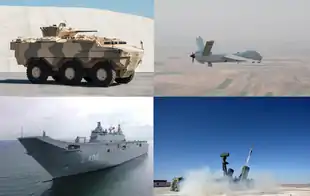
The Turkish Armed Forces consist of the General Staff, the Land Forces, the Naval Forces and the Air Force. The Chief of the General Staff is appointed by the President. President is responsible to the Parliament for matters of national security and the adequate preparation of the armed forces to defend the country. However, the authority to declare war and to deploy the Turkish Armed Forces to foreign countries or to allow foreign armed forces to be stationed in Turkey rests solely with the Parliament.[219]
The Gendarmerie General Command and the Coast Guard Command are law enforcement agencies with military organization (ranks, structure, etc.) and under the jurisdiction of the Ministry of the Interior. In wartime, the president can order certain units of the Gendarmerie General Command and the Coast Guard Command to operate under the Land Forces Command and Naval Forces Commands respectively. The remaining parts of the Gendarmerie and the Coast Guard continue to carry out their law enforcement missions under the jurisdiction of the Ministry of Interior.
Every fit male Turkish citizen otherwise not barred is required to serve in the military for a period ranging from three weeks to a year, dependent on education and job location.[220] Turkey does not recognise conscientious objection and does not offer a civilian alternative to military service.[221]
Turkey has the second-largest standing military force in NATO, after the United States, with an estimated strength of 890,700 military as of February 2022.[222] Turkey is one of five NATO member states which are part of the nuclear sharing policy of the alliance, together with Belgium, Germany, Italy, and the Netherlands.[223] A total of 90 B61 nuclear bombs are hosted at the Incirlik Air Base, 40 of which are allocated for use by the Turkish Air Force in case of a nuclear conflict, but their use requires the approval of NATO.[224]
Turkey has participated in international missions under the United Nations and NATO since the Korean War, including peacekeeping missions in Somalia, Yugoslavia and the Horn of Africa. It supported coalition forces in the First Gulf War, contributed military personnel to the International Security Assistance Force in Afghanistan, and remains active in Kosovo Force, Eurocorps and EU Battlegroups.[225][226] In recent years, Turkey has assisted Peshmerga forces in northern Iraq and the Somali Armed Forces with security and training.[227][228] Turkish Armed Forces have a relatively substantial military presence abroad,[229] with military bases in Albania,[230] Iraq,[231] Qatar,[232] and Somalia.[233] The country also maintains a force of 36,000 troops in Northern Cyprus since 1974.[234]
Human rights
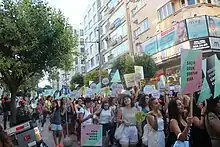
The human rights record of Turkey has been the subject of much controversy and international condemnation. Between 1959 and 2011 the European Court of Human Rights made more than 2400 judgements against Turkey for human rights violations on issues such as Kurdish rights, women's rights, LGBT rights, and media freedom.[235][236] Turkey's human rights record continues to be a significant obstacle to the country's membership of the EU.[237]
In the latter half of the 1970s, Turkey suffered from political violence between far-left and far-right militant groups, which culminated in the military coup of 1980.[238] The Kurdistan Workers' Party - a.k.a. PKK - (designated a terrorist organisation by Turkey, the United States,[138] and the European Union[139]) was founded in 1978 by a group of Kurdish militants led by Abdullah Öcalan, seeking the foundation of an independent Kurdish state based on Marxist-Leninist ideology.[239] The initial reason given by the PKK for this was the oppression of Kurds in Turkey.[240][241] A full-scale insurgency began in 1984, when the PKK announced a Kurdish uprising. With time the PKK modified its demands into equal rights for ethnic Kurds and provincial autonomy within Turkey.[242][243][244][245] Since 1980, the Turkish parliament stripped its members of immunity from prosecution, including 44 deputies most of which from the pro-Kurdish parties.[246]
According to the Committee to Protect Journalists, the AKP government has waged crackdowns on media freedom.[247][248] Many journalists have been arrested using charges of "terrorism" and "anti-state activities". In 2020, the CPJ identified 18 jailed journalists in Turkey (including the editorial staff of Cumhuriyet, Turkey's oldest newspaper still in circulation), all directly held for their published work; [249] while in 2020 Freemuse identified seven musicians imprisoned for their work. Some of which for promoting drug use in their lyrics.[250] [251]
LGBT rights
Homosexual activity is legal in Turkey since 1858.[253] LGBT people have had the right to seek asylum in Turkey under the Geneva Convention since 1951.[254] However, LGBT people in Turkey face discrimination, harassment and even violence from their relatives, neighbors, etc.[255] The Turkish authorities have carried out many discriminatory practices.[256][257][258] Despite these, LGBT acceptance in Turkey is growing. In a survey conducted by Kadir Has University in Istanbul in 2016, 33% of respondents said that LGBT people should have equal rights, which increased to 45% in 2020. Another survey by Kadir Has University in 2018 found that the proportion of people who would not want a homosexual neighbour decreased from 55% in 2018 to 47% in 2019.[259][260] A poll by Ipsos in 2015 found that 27% of the Turkish public was in favor of legalizing same-sex marriage and 19% supported civil unions instead.[261]
Istanbul Pride was held for the first time in 2003. Turkey became the first Muslim-majority country to hold a gay pride march.[262]
Geography

Turkey is a transcontinental country bridging Southeastern Europe and Western Asia. Asian Turkey, which includes 97 percent of the country's territory, is separated from European Turkey by the Bosphorus, the Sea of Marmara, and the Dardanelles. European Turkey comprises only 3 percent of the country's territory.[263] Turkey covers an area of 783,562 square kilometres (302,535 square miles),[264] of which 755,688 square kilometres (291,773 square miles) is in Asia and 23,764 square kilometres (9,175 square miles) is in Europe.[265] The country is encircled by seas on three sides: the Aegean Sea to the west, the Black Sea to the north and the Mediterranean Sea to the south. Turkey also contains the Sea of Marmara in the northwest.[266]
Turkey is divided into seven geographical regions: Marmara, Aegean, Black Sea, Central Anatolia, Eastern Anatolia, Southeastern Anatolia and the Mediterranean. The uneven north Anatolian terrain running along the Black Sea resembles a long, narrow belt. This region comprises approximately one-sixth of Turkey's total land area. As a general trend, the inland Anatolian plateau becomes increasingly rugged as it progresses eastward.[266] Pamukkale terraces are made of travertine, a sedimentary rock deposited by mineral water from the hot springs. The area is famous for a carbonate mineral left by the flowing of thermal spring water.[267][268] It is located in Turkey's Inner Aegean region, in the River Menderes valley, which has a temperate climate for most of the year. It was added as a UNESCO World Heritage Site in 1988 with Hierapolis.
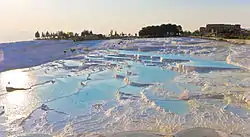
East Thrace; the European portion of Turkey, is located at the easternmost edge the Balkans. It forms the border between Turkey and its neighbours Greece and Bulgaria. The Asian part of the country mostly consists of the peninsula of Anatolia, which consists of a high central plateau with narrow coastal plains, between the Köroğlu and Pontic mountain ranges to the north and the Taurus Mountains to the south.
The Eastern Anatolia Region mostly corresponds to the western part of the Armenian Highlands (the plateau situated between the Anatolian Plateau in the west and the Lesser Caucasus in the north)[269] and contains Mount Ararat, Turkey's highest point at 5,137 metres (16,854 feet),[270] and Lake Van, the largest lake in the country.[271] Eastern Turkey has a mountainous landscape and is home to the sources of rivers such as the Euphrates, Tigris and Aras. The Southeastern Anatolia Region includes the northern plains of Upper Mesopotamia.
Far from the coast the climate of Turkey tends to be continental but elsewhere temperate, and has become hotter, and drier in parts. There are many species of plants and animals.
Biodiversity
Turkey's extraordinary ecosystem and habitat diversity has produced considerable species diversity.[272] Anatolia is the homeland of many plants that have been cultivated for food since the advent of agriculture, and the wild ancestors of many plants that now provide staples for humankind still grow in Turkey. The diversity of Turkey's fauna is even greater than that of its flora. The number of animal species in the whole of Europe is around 60,000, while in Turkey there are over 80,000 (over 100,000 counting the subspecies).[273]
The Northern Anatolian conifer and deciduous forests is an ecoregion which covers most of the Pontic Mountains in northern Turkey, while the Caucasus mixed forests extend across the eastern end of the range. The region is home to Eurasian wildlife such as the Eurasian sparrowhawk, golden eagle, eastern imperial eagle, lesser spotted eagle, Caucasian black grouse, red-fronted serin, and wallcreeper.[274] The narrow coastal strip between the Pontic Mountains and the Black Sea is home to the Euxine-Colchic deciduous forests, which contain some of the world's few temperate rainforests.[275] The Turkish pine (Pinus brutia) is mostly found in Turkey and other east Mediterranean countries; the other commonly found species of the genus Pinus (pine) in Turkey include the nigra, sylvestris, pinea and halepensis. The Turkey oak (Quercus cerris) and numerous other species of the genus Quercus (oak) exist in Turkey. The most commonly found species of the genus Platanus (plane) is the orientalis. Several wild species of tulip are native to Anatolia, and the flower was first introduced to Western Europe with species taken from the Ottoman Empire in the 16th century.[276][277]

There are 40 national parks, 189 nature parks, 31 nature preserve areas, 80 wildlife protection areas and 109 nature monuments in Turkey such as Gallipoli Peninsula Historical National Park, Mount Nemrut National Park, Ancient Troy National Park, Ölüdeniz Nature Park and Polonezköy Nature Park.[278] In the 21st century, threats to biodiversity include desertification due to climate change in Turkey.[279]
The Anatolian leopard is still found in very small numbers in the northeastern and southeastern regions of Turkey.[280][281] The Eurasian lynx and the European wildcat are other felid species which are currently found in the forests of Turkey. The Caspian tiger, now extinct, lived in the easternmost regions of Turkey until the latter half of the 20th century.[280][282]
Renowned domestic animals from Ankara, the capital of Turkey, include the Angora cat, Angora rabbit and Angora goat; and from Van Province the Van cat. The national dog breeds are the Kangal (Anatolian Shepherd), Malaklı and Akbaş.[283]
Climate
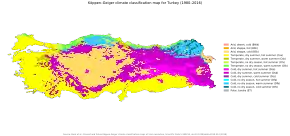
The coastal areas of Turkey bordering the Aegean and Mediterranean Seas have a temperate Mediterranean climate, with hot, dry summers and mild to cool, wet winters.[284] The coastal areas bordering the Black Sea have a temperate oceanic climate with warm, wet summers and cool to cold, wet winters.[284] The Turkish Black Sea coast receives the most precipitation and is the only region of Turkey that receives high precipitation throughout the year.[284] The eastern part of the Black Sea coast averages 2,200 millimetres (87 in) annually which is the highest precipitation in the country.[284] The coastal areas bordering the Sea of Marmara, which connects the Aegean Sea and the Black Sea, have a transitional climate between a temperate Mediterranean climate and a temperate oceanic climate with warm to hot, moderately dry summers and cool to cold, wet winters.[284] Snow falls on the coastal areas of the Sea of Marmara and the Black Sea almost every winter, but usually melts in no more than a few days.[284] However, snow is rare in the coastal areas of the Aegean Sea and very rare in the coastal areas of the Mediterranean Sea.[284] Winters on the Anatolian plateau are especially severe. Temperatures of −30 °C to −40 °C (−22 °F to −40 °F) do occur in northeastern Anatolia, and snow may lie on the ground for at least 120 days of the year, and during the entire year on the summits of the highest mountains. In central Anatolia the temperatures can drop below −20 °C ( -4 °F) with the mountains being even colder.
Mountains close to the coast prevent Mediterranean influences from extending inland, giving the central Anatolian plateau of the interior of Turkey a continental climate with sharply contrasting seasons.[284]
Economy
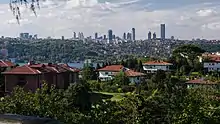
Turkey is a newly industrialized country, with an upper-middle income economy, which is the twentieth-largest in the world by nominal GDP, and the eleventh-largest by PPP. Turkey is one of the Emerging 7 countries. According to World Bank estimates, Turkey's GDP per capita by PPP is $38,759 in 2022[9] and approximately 11.7% of Turks are at risk of poverty or social exclusion as of 2019.[285] Unemployment in Turkey was 13.6% in 2019,[286] and the middle class population in Turkey rose from 18% to 41% of the population between 1993 and 2010 according to the World Bank.[287] As of September 2021, the foreign currency reserves of the Turkish Central Bank were $74.9 billion (an 8.1% increase compared to the previous month), its gold reserves were $38.5 billion (a 5.1% decrease compared to the previous month), while its official reserve assets stood at $121.3 billion.[288] As of October 2021, the foreign currency deposits of the citizens and residents in Turkish banks stood at $234 billion, equivalent to around half of all deposits.[289][290] The EU–Turkey Customs Union in 1995 led to an extensive liberalisation of tariff rates, and forms one of the most important pillars of Turkey's foreign trade policy.[291]
The automotive industry in Turkey is sizeable, and produced over 1.3 million motor vehicles in 2021, ranking as the 13th largest producer in the world.[292] Turkish automotive companies like TEMSA, Otokar and BMC are among the world's largest van, bus and truck manufacturers. Turkish shipyards are highly regarded both for the production of chemical and oil tankers up to 10,000 dwt and also for their mega yachts.[293] Turkish brands like Beko and Vestel are among the largest producers of consumer electronics and home appliances in Europe, and invest a substantial amount of funds for research and development in new technologies related to these fields.[294][295][296]
.svg.png.webp)
Other key sectors of the Turkish economy are banking, construction, home appliances, electronics, textiles, oil refining, petrochemical products, food, mining, iron and steel, and machine industry. In 2004, it was estimated that 46 percent of total disposable income was received by the top 20 percent of income earners, while the lowest 20 percent received only 6 percent.[297]
Foreign direct investment (FDI) in Turkey reached 22.05 billion USD in 2007 and 19.26 billion USD in 2015, but has declined in recent years.[298] In the economic crisis of 2016 it emerged that the huge debts incurred for investment during the AKP government since 2002 had mostly been consumed in construction, rather than invested in sustainable economic growth.[299] In 2020, according to Carbon Tracker, money was being wasted constructing more coal-fired power stations in Turkey.[300] International Energy Agency said that fossil fuel subsidies should be redirected, for example to the health system.[301] Fossil fuel subsidies were around 0.2% of GDP for the first two decades of the 21st century,[302][303] and are higher than clean energy subsidies.[304] The external costs of fossil fuel consumption in 2018 has been estimated as 1.5% of GDP.[305] In 2020 the European Bank for Reconstruction and Development offered to support a just transition away from coal.[306]
Turkey has seen a growth in video gaming industry during the recent years. Many game developing companies founded and gained investment from venture capitalists.[307] TaleWorlds Entertainment, Peak Games, Bigger Games and Dream Games are the current leaders in this sector.[308][309]
Tourism
%252C_Mu%C4%9Fla_Province%252C_southwest_Turkey%252C_Mediterranean.jpg.webp)
Tourism in Turkey has increased almost every year in the 21st century,[310] and is an important part of the economy. The Turkish Ministry of Culture and Tourism currently promotes Turkish tourism under the project Turkey Home. Turkey is one of the world's top ten destination countries, with the highest percentage of foreign visitors arriving from Europe; specially Germany and Russia in recent years.[310] In 2019, Turkey ranked sixth in the world in terms of the number of international tourist arrivals behind Italy, with 51.2 million foreign tourists visiting the country.[311] Turkey has 19 UNESCO World Heritage Sites, and 84 World Heritage Sites in tentative list. Turkey is home to 519 Blue Flag beaches, which makes it in the third place in the world.[312] Istanbul is the tenth most visited city in the world with 13,433,000 annual visitors as of 2018.[313] Antalya is the second most visited city in Turkey, with over 9 million tourists in 2021.[314]
Infrastructure

In 2013 there were 98 airports in Turkey,[316] including 22 international airports.[317] İstanbul Airport is planned to be the largest airport in the world, with a capacity to serve 150 million passengers a year.[318][319] As well as Turkish Airlines, flag carrier of Turkey since 1933, several other airlines operate in the country. It operates scheduled services to 315 destinations in Europe, Asia, Africa, and the Americas, making it the largest mainline carrier in the world by number of passenger destinations.[320][321][322] Turkish Airlines uses Istanbul Airport of 90 million capacity as its main hub.
As of 2014, the country has a roadway network of over 65,000 kilometres (40,400 miles).[323] Motorways are controlled-access highways that are officially named Otoyol. The network spans 3,523 kilometres (2,189 mi) as of 2020. The network is expected to expand to 4,773 kilometres (2,966 mi) by 2023 and to 9,312 kilometres (5,786 mi) by 2035.[324]
Turkish State Railways operates both conventional and high speed trains on 12,532 kilometres rail length. The government-owned national railway company started building high-speed rail lines in 2003. The Ankara-Konya line became operational in 2011, while the Ankara-Istanbul line entered service in 2014.[325] Konya-Karaman line started its operations in 2022 and 406 km (252 mi) long Ankara-Sivas line is to open in 2022.
Opened in 2013, the Marmaray tunnel under the Bosphorus connects the railway and metro lines of Istanbul's European and Asian sides; while the nearby Eurasia Tunnel (2016) provides an undersea road connection for motor vehicles.[326]
Istanbul Metro is the largest metro network in the country with 495 million annual ridership.[327] There are 9 metro lines under service and 6 more under construction.[328]
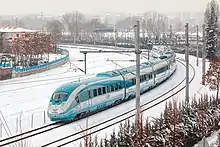
The Bosphorus Bridge (1973), Fatih Sultan Mehmet Bridge (1988) and Yavuz Sultan Selim Bridge (2016) are the three suspension bridges connecting the European and Asian shores of the Bosphorus strait. The Osman Gazi Bridge (2016) connects the northern and southern shores of the Gulf of İzmit. The Çanakkale 1915 Bridge on the Dardanelles strait, connecting Europe and Asia, is the longest suspension bridge in the world.[330]
Many natural gas pipelines span the country's territory.[159] The Blue Stream, a major trans-Black Sea gas pipeline, delivers natural gas from Russia to Turkey. The undersea pipeline, Turkish Stream, with an annual capacity around 63 billion cubic metres (2,200 billion cubic feet), allows Turkey to resell Russian gas to the rest of Europe.[331] The Baku-Tbilisi-Ceyhan pipeline, the second longest oil pipeline in the world, was inaugurated in 2005.[332] As of 2018 Turkey consumes 1700 terawatt hours (TW/h) of primary energy per year, a little over 20 megawatt hours (MW/h) per person, mostly from imported fossil fuels.[333] Although the energy policy of Turkey includes reducing fossil-fuel imports, coal in Turkey is the largest single reason why greenhouse gas emissions by Turkey amount to 1% of the global total. Renewable energy in Turkey is being increased and Akkuyu Nuclear Power Plant is being built on the Mediterranean coast: but despite national electricity generation overcapacity fossil fuels are still subsidized.[334] Turkey has the fifth-highest direct utilisation and capacity of geothermal power in the world.[335]
As of 2019, Turkey produces 45.6% of its electricity from renewable sources.[336]
Science and technology
TÜBİTAK is the leading agency for developing science, technology and innovation policies in Turkey.[337] TÜBA is an autonomous scholarly society acting to promote scientific activities in Turkey.[338] TAEK is the country's official nuclear energy institution, focused on academic research and the development and implementation of peaceful nuclear technology.[339] It is supervising the construction of Turkey's first nuclear facility, Akkuyu Nuclear Power Plant in Mersin, at the cost of $20 billion; the plant is expected to be operational in May 2023,[340] and is projected to meet around 10% of the country's electricity demand.
.JPG.webp)
The Turkish government invests heavily in research and development of military technologies, including Turkish Aerospace Industries, ASELSAN, HAVELSAN, ROKETSAN, and MKE. Turkey is a global leader in unmanned aerial vehicles (UAV); the Bayraktar TB2, manufactured by private defence company Baykar, has been exported to over a dozen countries and played a decisive role in several conflicts, including the 2020 Nagorno-Karabakh war and the 2022 Russian invasion of Ukraine.[341][342]
Turkey has made significant inroads in aerospace technology into the 21st century. In 2013, it initiated the Turkish Space Launch System (UFS) to develop an independent satellite launch capability, including the construction of a spaceport, the development of satellite launch vehicles, and the establishment of remote earth stations.[343][344][345] Türksat, the country's sole communications satellite operator, has launched a series of satellites into orbit; likewise, the Turkish Satellite Assembly, Integration and Test Center (UMET)—a spacecraft production and testing facility owned by the Ministry of National Defence and operated by the TAI—has launched the Göktürk series of Earth observation satellites for reconnaissance; BILSAT-1 and RASAT are the scientific Earth observation satellites operated by the TÜBİTAK Space Technologies Research Institute.
In 2015, Aziz Sancar, a Turkish professor at the University of North Carolina, won the Nobel Prize in Chemistry for his work on how cells repair damaged DNA;[346] he is one of two Turkish Nobel laureates, and the first in the sciences. Other prominent Turkish scientists include physician Hulusi Behçet, who discovered Behçet's disease; mathematician Cahit Arf, who defined the Arf invariant; and immunologists Uğur Şahin and Özlem Türeci, whose German biotechnology company, BioNTech, developed one of the first efficacious vaccines against COVID-19.
Turkey is among the top fifty most innovative countries in the world, ranking 41st in the Global Innovation Index in 2021; this represents a considerable increase since 2011, where it was ranked 65th.[347]
Demographics
According to the Address-Based Population Recording System of Turkey, the country's population was 74.7 million people in 2011,[350] nearly three-quarters of whom lived in towns and cities. According to the 2011 estimate, the population is increasing by 1.35 percent each year. Turkey has an average population density of 97 people per km². People within the 15–64 age group constitute 67.4 percent of the total population; the 0–14 age group corresponds to 25.3 percent; while senior citizens aged 65 years or older make up 7.3 percent.[351]
Article 66 of the Turkish Constitution defines a "Turk" as "anyone who is bound to the Turkish state through the bond of citizenship"; therefore, the legal use of the term "Turkish" as a citizen of Turkey is different from the ethnic definition.[352] However approximately 70 to 80 percent of the country's citizens are ethnic Turks.[353][4] It is estimated that there are at least 47 ethnic groups represented in Turkey.[354] Reliable data on the ethnic mix of the population is not available, because Turkish census figures do not include statistics on ethnicity.[355]
Kurds are the largest non-Turkish ethnicity at anywhere from 12–25 per cent of the population.[356][357] The exact figure remains a subject of dispute; according to Servet Mutlu, "more often than not, these estimates reflect pro-Kurdish or pro-Turkish sympathies and attitudes rather than scientific facts or erudition".[354] Mutlu's 1990 study estimated Kurds made up around 12 per cent of the population.[358] The Kurds make up a majority in the provinces of Ağrı, Batman, Bingöl, Bitlis, Diyarbakır, Hakkari, Iğdır, Mardin, Muş, Siirt, Şırnak, Tunceli and Van; a near majority in Şanlıurfa Province (47%); and a large minority in Kars Province (20%).[359] In addition, due to internal migration, Kurdish diaspora communities exist in all of the major cities in central and western Turkey. In Istanbul, there are an estimated three million Kurds, making it the city with the largest Kurdish population in the world.[360] Non-Kurdish minorities are believed to make up an estimated 7–12 percent of the population.[4]
The three "Non-Muslim" minority groups recognised in the Treaty of Lausanne were Armenians, Greeks and Jews. Other ethnic groups include Albanians, Arabs, Assyrians, Bosniaks, Circassians, Georgians, Laz, Pomaks, and Roma.[4][361][362][363][364] Turkey is also home to a Muslim community of Megleno-Romanians.[365]
Before the start of the Syrian civil war in 2011, the estimated number of Arabs in Turkey varied from 1 million to more than 2 million.[366] As of April 2020, there are 3.6 million Syrian refugees in Turkey, who are mostly Arabs but also include Syrian Kurds, Syrian Turkmen, and other ethnic groups of Syria. The vast majority of these are living in Turkey with temporary residence permits. The Turkish government has granted Turkish citizenship to refugees who have joined the Syrian National Army.[367][368][369]
Largest cities or towns in Turkey TÜİK's address-based calculation from December 2017. | |||||||||
|---|---|---|---|---|---|---|---|---|---|
| Rank | Name | Province | Pop. | Rank | Name | Province | Pop. | ||
 Istanbul 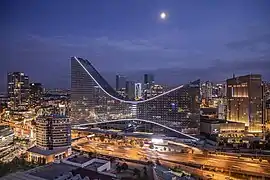 Ankara |
1 | Istanbul | Istanbul | 14,744,519 | 11 | Mersin | Mersin | 1,005,455 |  İzmir  Bursa |
| 2 | Ankara | Ankara | 4,871,884 | 12 | Urfa | Şanlıurfa | 921,978 | ||
| 3 | İzmir | İzmir | 2,938,546 | 13 | Eskişehir | Eskişehir | 752,630 | ||
| 4 | Bursa | Bursa | 2,074,799 | 14 | Denizli | Denizli | 638,989 | ||
| 5 | Adana | Adana | 1,753,337 | 15 | Kahramanmaraş | Kahramanmaraş | 632,487 | ||
| 6 | Gaziantep | Gaziantep | 1,663,273 | 16 | Samsun | Samsun | 625,410 | ||
| 7 | Antalya | Antalya | 1,311,471 | 17 | Malatya | Malatya | 618,831 | ||
| 8 | Konya | Konya | 1,130,222 | 18 | İzmit | Kocaeli | 570,077 | ||
| 9 | Kayseri | Kayseri | 1,123,611 | 19 | Adapazarı | Sakarya | 492,027 | ||
| 10 | Diyarbakır | Diyarbakır | 1,047,286 | 20 | Erzurum | Erzurum | 422,389 | ||
Immigration
Millions of Kurds fled across the mountains to Turkey and Kurdish areas of Iran during the Gulf War in 1991. Immigration to Turkey is the process by which people migrate to Turkey to reside in the country. Turkey's migrant crisis created after an estimated 2.5 percent of the population are international migrants.[370] Turkey hosts the largest number of refugees in the world, including 3.6 million Syrian refugees, as of April 2020.[367] As part of Turkey's migrant crisis, according to UNHCR, in 2018 Turkey was hosting 63.4% of all the refugees in the world, that is 3,564,919 registered refugees from Africa and the Middle East in total.[371]
Languages
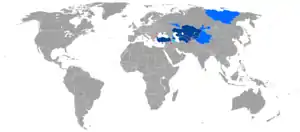
The official language is Turkish, which is the most widely spoken Turkic language in the world.[372][373] It is spoken by 85.54 percent of the population as a first language.[374] 11.97 percent of the population speaks the Kurmanji dialect of Kurdish as their mother tongue.[374] Arabic and Zaza are the mother tongues of 2.39 percent of the population, and several other languages are the mother tongues of smaller parts of the population.[374] Endangered languages in Turkey include Abaza, Abkhaz, Adyghe, Cappadocian Greek, Gagauz, Hértevin, Homshetsma, Kabard-Cherkes, Ladino (Judesmo), Laz, Mlahso, Pontic Greek, Romani, Suret, Turoyo, Ubykh, and Western Armenian.[375] Megleno-Romanian is also spoken.[365]
Turkey is a founding member of the Organization of Turkic States and International Organization of Turkic Culture, comprising other independent Turkic states, such as Azerbaijan, Kazakhstan, Kyrgyzstan, Turkey and Uzbekistan. It is an intergovernmental organization whose overarching aim is promoting comprehensive cultural cooperation among Turkic-speaking states.
Religion

Turkey is a secular state with no official state religion; the Turkish Constitution provides for freedom of religion and conscience.[378][379] A 2016 survey by Ipsos, interviewing 17,180 adults across 22 countries, found that Islam was the dominant religion in Turkey, adhered to by 82% of the total population; religiously unaffiliated people comprised 13% of the population, while 2% were Christians.[380] The level of religiosity study by Konda found that 9.7% of the population who are 'fully devoted', 52% who 'strives to fulfill religious obligations', 34.3% who 'does not fulfill religious obligations' and 3.2% 'Nonbeliever/Irreligious'.[381][382] Another poll conducted by Gezici Araştırma in 2020 interviewed 1,062 people in 12 provinces and found that 28.5% of the Generation Z in Turkey identify as irreligious.[383][384] According to a survey by World Values Survey In 2017 98.0% Identified as Muslims, while 1.2% Identified with no Religion and 0.8 as other.[385]
According to a survey by the pollster KONDA, the percentage of atheists in Turkey has tripled in 10 years and rose from 1% in 2008 to 3% in 2018, the percentage of non-believers or agnostics rose from 1% to 2%, and that 90% of irreligious Turks were under 35 years old. The survey was conducted in Turkey through face-to-face interviews with 5,793 people in their households, in April, 2018 while in 2008 6,482 people were interviewed in face-to-face in Turkey.[386][387][388]
The CIA World Factbook reports that Islam is the religion of 99.8% of the population, with Sunni Muslims as the largest sect, while 0.2% are Christians and Jews.[389] However, there are no official governmental statistics specifying the religious beliefs of the Turkish people, nor is religious data recorded in the country's census.[390] Academics suggest the Alevi population may be from 15 to 20 million, while the Alevi-Bektaşi Federation states that there are around 25 million.[391][392] According to Aksiyon magazine, the number of Twelver Shias (excluding Alevis) is three million (4.2%).[393]
Christianity has a long history in present-day Turkey, which is the birthplace of numerous Christian apostles and saints. Antioch (Antakya) is regarded by tradition as the spot where the Gospels were written, and where the followers of Jesus were called Christians for the first time. Constantinople is generally considered to be the center and the "cradle of Orthodox Christian civilization".[394][395] The percentage of Christians in Turkey fell from 17.5% (three million followers) in a population of 16 million to 2.5% percent in the early 20th century.[396] mainly as a result of the Armenian genocide, the population exchange between Greece and Turkey and the emigration of Christians that began in the late 19th century and gained pace in the first quarter of the 20th century.[397][398] Today, there are more than 120,000–320,000 people of various Christian denominations,[399] representing less than 0.2% of Turkey's population,[400] including an estimated 80,000 Oriental Orthodox, 35,000 Roman Catholics,[401] 18,000 Antiochian Greeks,[402] 5,000 Greek Orthodox, smaller numbers of Protestants,[403] and 512 Mormons.[404] Currently, there are 398 churches open for worship in Turkey.[405]
Modern-day Turkey continues to have a small Jewish population;[406] with around 26,000 Jews, the vast majority of whom are Sephardi.[407] Turkey has the biggest Jewish community among the Muslim-majority countries.[408][409]
In a mid-2010s poll, 2.9% of Turkish respondents identified as atheists.[410] The Association of Atheism, the first official atheist organisation in the Balkans and the Middle East, was founded in 2014.[411][412] Some religious and secular officials have claimed that atheism and deism are growing among Turkish people.[413][414][415][416]
Education
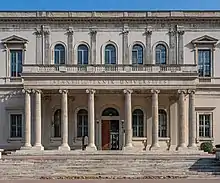
The Ministry of National Education is responsible for pre-tertiary education.[418] This is compulsory and lasts twelve years: four years each of primary school, middle school and high school.[419] All 12 years compulsory education is free of charge in public schools.[420]
Basic education in Turkey is said to lag behind other OECD countries, with significant differences between high and low performers.[421] Access to high-quality school heavily depends on the performance in the secondary school entrance exams, to the point that some students begin taking private tutoring classes when they are ten years old.[421]
As of 2022, there are 209 universities in Turkey.[422] Except for the Open Education Faculties (AÖF) at Anadolu, Istanbul and Atatürk University; entrance is regulated by the national Student Selection and Placement System (Turkish: Öğrenci Seçme ve Yerleştirme Sistemi, ÖSYS) examination, after which high school graduates are assigned to universities according to their performance.[423] According to the 2012–2013 Times Higher Education World University Rankings, the top university in Turkey is Middle East Technical University, followed by Bilkent University and Koç University, Istanbul Technical University and Boğaziçi University.[424] All state and private universities are under the control of the Higher Education Board (Turkish: Yükseköğretim Kurulu, YÖK), whose head is appointed by the President of Turkey; and since 2016 the President directly appoints all rectors of all state and private universities.[425]

Turkey is a member of Socrates programme, Erasmus Programme and Erasmus+ Programmes. These student exchange programmes are organised by the European Union.[427] Also it is a member of Erasmus Student Network which is a Europe-wide student organisation which has more than 15.000 volunteers across the Europe.[428]
Turkey has become a hub for foreign students in recent years. The number of foreign students in Turkey was 795.962 in 2016.[429] The government has announced a vision to draw around 500,000 foreign students at its universities by offering attractive scholarships.[430] Türkiye Scholarships is international scholarship programme funded by Government of Turkey. In 2021, in response to Türkiye Scholarships, that was advertised in January 2021, Turkish Government received 165,000 applications from 178 countries of the World.[431][432][433]
Health
.jpg.webp)
The Ministry of Health has run a universal public healthcare system since 2003.[434] Known as Universal Health Insurance (Genel Sağlık Sigortası), it is funded by a tax surcharge on employers, currently at 5%.[434] Public-sector funding covers approximately 75.2% of health expenditures.[434] Despite the universal health care, total expenditure on health as a share of GDP in 2018 was the lowest among OECD countries at 6.3% of GDP, compared to the OECD average of 9.3%.[434] The lower health care expenditure is due to lower median age in Turkey which is 32.4, compared to Italy which is 47.3.[435] Aging population is the prime reason for higher healthcare expenditure in the developed world.[436]
Average life expectancy is 78.6 years (75.9 for males and 81.3 for females), compared with the EU average of 81 years.[434] Turkey has high rates of obesity, with 29.5% of its adult population having a body mass index (BMI) value that is 30 or above.[437] Air pollution in Turkey is a major cause of early death.[438]
There are many private hospitals in the country. Turkey benefits from medical tourism in the recent years. Health tourism earns above $1 billion to Turkey in 2019. Some 60% of the income is obtained from plastic surgery and a total of 662,087 patients received service in the country last year within the scope of health tourism.[439]
Culture
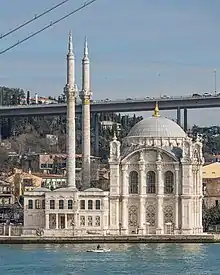
Turkey has a very diverse culture that is a blend of various elements of the Turkic, Anatolian, Byzantine, Ottoman (which was itself a continuation of both Greco-Roman and Islamic cultures) and Western culture and traditions, which started with the Westernisation of the Ottoman Empire and still continues today.[440][441] This mix originally began as a result of the encounter of Turks and their culture with those of the peoples who were in their path during their migration from Central Asia to the West.[440][442] Turkish culture is a product of efforts to be a "modern" Western state, while maintaining traditional religious and historical values.[440]
Turkish culture also influenced the European art and fashion particularly during the period of 16th to 18th centuries at the peak of Ottoman power. This phenomenan is also called Turquerie.
Visual arts
Ottoman miniature is linked to the Persian miniature tradition, as well as strong Chinese artistic influences. The words tasvir or nakış were used to define the art of miniature painting in Ottoman Turkish. The studios the artists worked in were called nakkaşhane.[443] The miniatures were usually not signed, perhaps because of the rejection of individualism, but also because the works were not created entirely by one person; the head painter designed the composition of the scene, and his apprentices drew the contours (which were called tahrir) with black or coloured ink and then painted the miniature without creating an illusion of depth. The head painter, and much more often the scribe of the text, were indeed named and depicted in some of the manuscripts. The understanding of perspective was different from that of the nearby European Renaissance painting tradition, and the scene depicted often included different time periods and spaces in one picture. They followed closely the context of the book they were included in, more illustrations than standalone works of art.[444] Matrakçı Nasuh (1480–1564) is one of the most prominent artists of this era.
Turkish painting, in the Western sense, developed actively starting from the mid 19th century. The first painting lessons were scheduled at what is now the Istanbul Technical University (then the Imperial Military Engineering School) in 1793, mostly for technical purposes.[445] In the late 19th century, human figure in the Western sense was being established in Turkish painting, especially with Osman Hamdi Bey (1842–1910). Impressionism, among the contemporary trends, appeared later on with Halil Pasha (c.1857–1939). Other important Turkish painters in the 19th century were Ferik İbrahim Paşa (1815–1891), Osman Nuri Paşa (c.1839–1906), Şeker Ahmet Paşa (1841–1907), and Hoca Ali Riza (1864–1939).

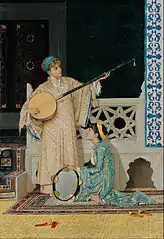
The young Turkish artists sent to Europe in 1926 came back inspired by contemporary trends such as Fauvism, Cubism and Expressionism, still very influential in Europe. The later "Group D" of artists led by Abidin Dino, Cemal Tollu, Fikret Mualla, Fahrünnisa Zeid, Bedri Rahmi Eyüboğlu, Adnan Çoker and Burhan Doğançay introduced some trends that had lasted in the West for more than three decades.
Other important movements in Turkish painting were the "Yeniler Grubu" (The Newcomers Group) of the late 1930s; the "On'lar Grubu" (Group of Ten) of the 1940s; the "Yeni Dal Grubu" (New Branch Group) of the 1950s; and the "Siyah Kalem Grubu" (Black Pen Group) of the 1960s.[446]
Internationally acclaimed Turkish sculptors in the 20th century include Ali Hadi Bara, Zühtü Müridoğlu, İlhan Koman, Kuzgun Acar and Ali Teoman Germaner.
Carpet (halı) and tapestry (kilim) weaving is a traditional Turkish art form with roots in pre-Islamic times. During its long history, the art and craft of weaving carpets and tapestries in Turkey has integrated numerous cultural traditions. Apart from the Turkic design patterns that are prevalent, traces of Persian and Byzantine patterns can also be detected. There are also similarities with the patterns used in Armenian, Caucasian and Kurdish carpet designs. The arrival of Islam in Central Asia and the development of Islamic art also influenced Turkic patterns in the medieval period. The history of the designs, motifs and ornaments used in Turkish carpets and tapestries thus reflects the political and ethnic history of the Turks and the cultural diversity of Anatolia. However, scientific attempts were unsuccessful, as yet, to attribute a particular design to a specific ethnic, regional, or even nomadic versus village tradition.[447]

The earliest examples of Turkish paper marbling, called ebru in Turkish, are said to be a copy of the Hâlnâme by the poet Arifî. The text of this manuscript was rendered in a delicate cut paper découpage calligraphy by Mehmed bin Gazanfer and completed in 1540, and features many marbled and decorative paper borders. One early master by the pseudonym of Şebek is mentioned posthumously in the earliest Ottoman text on the art known as the Tertib-i Risâle-i Ebrî, which is dated based on internal evidence to after 1615. The instructions for several ebru techniques in the text are accredited to this master. Another famous 18th-century master by the name of Hatip Mehmed Efendi (died 1773) is accredited with developing motifs and perhaps early floral designs, although evidence from India appears to contradict some of these reports. Despite this, marbled motifs are commonly referred to as hatip designs in Turkey today.[449]
Literature and theatre
Turkish literature is a mix of cultural influences. Interaction between the Ottoman Empire and the Islamic world along with Europe contributed to a blend of Turkic, Islamic and European traditions in modern-day Turkish music and literary arts.[452] Turkish literature was heavily influenced by Persian and Arabic literature during most of the Ottoman era.
The Tanzimat reforms of the 19th century introduced previously unknown Western genres, primarily the novel and the short story. Many of the writers in the Tanzimat period wrote in several genres simultaneously: for instance, the poet Nâmık Kemal also wrote the important 1876 novel İntibâh (Awakening), while the journalist Şinasi has written, in 1860, the first modern Turkish play, the one-act comedy "Şair Evlenmesi" (The Poet's Marriage). Most of the roots of modern Turkish literature were formed between the years 1896 and 1923. Broadly, there were three primary literary movements during this period: the Edebiyat-ı Cedîde (New Literature) movement; the Fecr-i Âtî (Dawn of the Future) movement; and the Millî Edebiyat (National Literature) movement.
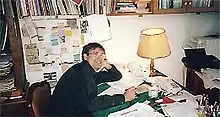
The first radical step of innovation in 20th century Turkish poetry was taken by Nâzım Hikmet, who introduced the free verse style. Another revolution in Turkish poetry came about in 1941 with the Garip movement led by Orhan Veli, Oktay Rıfat and Melih Cevdet. The mix of cultural influences in Turkey is dramatised, for example, in the form of the "new symbols of the clash and interlacing of cultures" enacted in the novels of Orhan Pamuk, recipient of the 2006 Nobel Prize in Literature.[453]
The origin of Turkish theatre dates back to ancient pagan rituals and oral legends. The dances, music and songs performed during the rituals of the inhabitants of Anatolia millennia ago are the elements from which the first shows originated. In time, the ancient rituals, myths, legends and stories evolved into theatrical shows. Starting from the 11th-century, the traditions of the Seljuk Turks blended with those of the indigenous peoples of Anatolia and the interaction between diverse cultures paved the way for new plays.

After the Tanzimat (Reformation) period in the 19th century, characters in Turkish theatre were modernised and plays were performed on European-style stages, with actors wearing European costumes. Following the restoration of constitutional monarchy with the Young Turk Revolution in 1908, theatrical activities increased and social problems began to be reflected at the theatre as well as in historical plays. A theatrical conservatoire, Darülbedayi-i Osmani (which became the nucleus of the Istanbul City Theatres) was established in 1914. During the years of chaos and war, the Darülbedayi-i Osmani continued its activities and attracted the younger generation. Numerous Turkish playwrights emerged in this era; some of them wrote on romantic subjects, while others were interested in social problems, and still others dealt with nationalistic themes. The first Turkish musicals were also written in this period. In time, Turkish women began to appear on stage, which was an important development in the late Ottoman society. Until then, female roles had only been played by actresses who were members of Turkey's ethnic minorities. Today there are numerous private theatres in the country, together with those which are subsidised by the government, such as the Turkish State Theatres.[454]
Music and dance
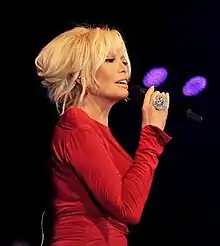
Music of Turkey includes mainly Turkic elements as well as partial influences ranging from Central Asian folk music, Arabic music, Greek music, Ottoman music, Persian music and Balkan music, as well as references to more modern European and American popular music. The roots of traditional music in Turkey span across centuries to a time when the Seljuk Turks migrated to Anatolia and Persia in the 11th century and contains elements of both Turkic and pre-Turkic influences. Much of its modern popular music can trace its roots to the emergence in the early 1930s drive for Westernization.[456]
With the assimilation of immigrants from various regions the diversity of musical genres and musical instrumentation also expanded. Turkey has also seen documented folk music and recorded popular music produced in the ethnic styles of Greek, Armenian, Albanian, Polish and Jewish communities, among others.[457]
Many Turkish cities and towns have vibrant local music scenes which, in turn, support a number of regional musical styles. Despite this however, western music styles like pop music and kanto lost popularity to arabesque in the late 1970s and 1980s. It became popular again by the beginning of the 1990s, as a result of an opening economy and society. With the support of Sezen Aksu, the resurging popularity of pop music gave rise to several international Turkish pop stars such as Ajda Pekkan, Tarkan and Sertab Erener. Internationally acclaimed Turkish jazz and blues musicians and composers include Ahmet Ertegun (founder and president of Atlantic Records), Nükhet Ruacan and Kerem Görsev.
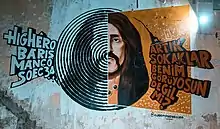
The Turkish Five is a name used by some authors to identify the five pioneers of Western classical music in Turkey, namely Ahmed Adnan Saygun, Ulvi Cemal Erkin, Cemal Reşit Rey, Hasan Ferit Alnar and Necil Kazım Akses.[458] Internationally acclaimed Turkish musicians of Western classical music include pianists İdil Biret, Verda Erman, Gülsin Onay, the Pekinel sisters (Güher and Süher Pekinel), Ayşegül Sarıca and Fazıl Say; violinists Ayla Erduran and Suna Kan; opera singers Semiha Berksoy, Leyla Gencer and Güneş Gürle; and conductors Emre Aracı, Gürer Aykal, Erol Erdinç, Rengim Gökmen and Hikmet Şimşek.
Turkish folk dance is diverse. Hora is performed in East Thrace; Zeybek in the Aegean Region, Southern Marmara and East-Central Anatolia Region; Teke in the Western Mediterranean Region; Kaşık Oyunları and Karşılama in West-Central Anatolia, Western Black Sea Region, Southern Marmara Region and Eastern Mediterranean Region; Horon in the Central and Eastern Black Sea Region; Halay in Eastern Anatolia and the Central Anatolia Region; and Bar and Lezginka in the Northeastern Anatolia Region.[459]
Architecture
.jpg.webp)

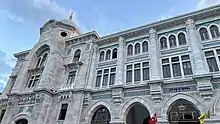

The Byzantine era is usually dated from 330 AD, when Constantine the Great moved the Roman capital to Byzantium, which became Constantinople, until the fall of the Byzantine Empire in 1453. Its architecture dramatically influenced the later medieval architecture throughout Europe and the Near East, and became the primary progenitor of the Renaissance and Ottoman architectural traditions that followed its collapse.[460] When the Roman Empire went Christian (as well as Eastwards) with its new capital at Constantinople, its architecture became more sensuous and more ambitious. This new style would come to be known as Byzantine with increasingly exotic domes and ever-richer mosaics, traveled west to Ravenna and Venice and as far north as Moscow.[461] This influence can be seen particularly in the Venetian Gothic architecture.
The architecture of the Seljuk Turks combined the elements and characteristics of the Turkic architecture of Central Asia with those of Persian, Arab, Armenian and Byzantine architecture. The transition from Seljuk architecture to Ottoman architecture is most visible in Bursa, which was the capital of the Ottoman State between 1335 and 1413. Following the Ottoman conquest of Constantinople (Istanbul) in 1453, Ottoman architecture was significantly influenced by Byzantine architecture. Topkapı Palace in Istanbul is one of the most famous examples of classical Ottoman architecture and was the primary residence of the Ottoman Sultans for approximately 400 years.[462] Mimar Sinan (c.1489–1588) was the most important architect of the classical period in Ottoman architecture. He was the chief architect of at least 374 buildings that were constructed in various provinces of the Ottoman Empire in the 16th century.[463] Sedefkar Mehmed Agha also known as the architect of the Blue Mosque was an Albanian origin Devshirme. He became a pupil of architect Mimar Sinan, becoming his first assistant in charge of the office in the absence of Sinan. His work heavily influenced by his teacher Mimar Sinan
Since the 18th century, Turkish architecture has been increasingly influenced by European styles, and this can be particularly seen in the Tanzimat era buildings of Istanbul like the Dolmabahçe, Çırağan, Taksim Military Barracks (demolished), Feriye, Beylerbeyi, Küçüksu, Ihlamur and Yıldız palaces, which were all designed by members of the Balyan family of Ottoman Armenian court architects.[464] The Ottoman era waterfront houses (yalı) on the Bosphorus also reflect the fusion between classical Ottoman and European architectural styles during the aforementioned period. Italian architect, Raimondo D'Aronco served as the chief palace architect to the Ottoman Sultan Abdülhamid II in Istanbul for 16 years. D'Aronco designed and built a large number of buildings of various types in Istanbul. The stylistic features of his works can be classified in three groups: Revivalism, reinterpretation of the Ottoman forms, Art Nouveau and Vienna Secession. Art Nouveau was first introduced to Istanbul by D'Aronco, and his designs reveal that he drew freely on Byzantine and Ottoman decorations. He also mixed Western and Oriental styles in his work.
The First National Architectural Movement in the early 20th century sought to create a new architecture, which was based on motifs from Seljuk and Ottoman architecture. The leading architects of this movement were Vedat Tek (1873–1942), Mimar Kemaleddin Bey (1870–1927), Arif Hikmet Koyunoğlu (1888–1982) and Giulio Mongeri (1873–1953).[465] Buildings from this era are the Grand Post Office in Istanbul (1905–1909), Tayyare Apartments (1919–1922),[466] Istanbul 4th Vakıf Han (1911–1926),[467] State Art and Sculpture Museum (1927–1930),[468] Ethnography Museum of Ankara (1925–1928),[469] the first Ziraat Bank headquarters in Ankara (1925–1929),[470] the first Türkiye İş Bankası headquarters in Ankara (1926–1929),[471] Bebek Mosque,[472] and Kamer Hatun Mosque.[473][474]
Some of the notable contemporary architects of Turkey are Behruz Çinici, Emre Arolat, Murat Tabanlıoğlu, Melkan Tabanlıoğlu, Melike Altınışık, Zeynep Fadıllıoğlu and Mehmet Kütükçüoğlu
Cuisine
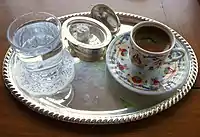

Turkish cuisine is largely the heritage of Ottoman cuisine. In the early years of the Republic, a few studies were published about regional Anatolian dishes but cuisine did not feature heavily in Turkish folkloric studies until the 1980s, when the fledgling tourism industry encouraged the Turkish state to sponsor two food symposia. The papers submitted at the symposia presented the history of Turkish cuisine on a "historical continuum" that dated back to Turkic origins in Central Asia and continued through the Seljuk and Ottoman periods.[479]
Many of the papers presented at these first two symposia were unreferenced. Prior to the symposia, the study of Turkish culinary culture was first popularised by the publication of Süheyl Ünver's Fifty Dishes in Turkish History in 1948. This book was based on recipes found in an 18th century Ottoman manuscript. His second book was about palace cuisine during the reign of Mehmet II. Following the publication of Ünver's book subsequent studies were published, including a 1978 study by a historian named Bahaettin Ögel about the Central Asian origins of Turkish cuisine.[479]
Ottoman cuisine contains elements of Turkish, Byzantine, Balkan, Armenian, Kurdish, Arab and Persian cuisines.[480] The country's position between Europe, Asia, and the Mediterranean Sea helped the Turks in gaining complete control of the major trade routes, and an ideal landscape and climate allowed plants and animals to flourish. Turkish cuisine was well established by the mid-1400s, the beginning of the Ottoman Empire's 600-year reign. Yogurt salads, fish in olive oil, sherbet and stuffed and wrapped vegetables became Turkish staples. The empire, eventually spanning from Austria and Ukraine to Arabia and North Africa, used its land and water routes to import exotic ingredients from all over the world. By the end of the 16th century, the Ottoman court housed over 1,400 live-in cooks and passed laws regulating the freshness of food. Since the fall of the empire in World War I (1914–1918) and the establishment of the Turkish Republic in 1923, foreign food such as French hollandaise sauce and Western fast food have made their way into the modern Turkish diet.[481]
Sports
The most popular sport in Turkey is association football.[482] Galatasaray won the UEFA Cup and UEFA Super Cup in 2000.[483] The Turkish national football team won the bronze medal at the 2002 FIFA World Cup, the 2003 FIFA Confederations Cup and UEFA Euro 2008.[484]
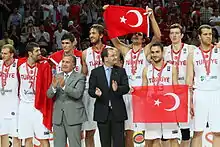
Other mainstream sports such as basketball and volleyball are also popular. The men's national basketball team won the silver medal at the 2010 FIBA World Championship and at EuroBasket 2001, which were both hosted by Turkey; and is one of the most successful at the Mediterranean Games. Turkish basketball club Fenerbahçe reached the final of the EuroLeague in three consecutive seasons (2016, 2017 and 2018), becoming the European champions in 2017 and runners-up in 2016 and 2018. Another Turkish basketball club, Anadolu Efes S.K. won the 2020–21 EuroLeague and the 1995–96 FIBA Korać Cup, were the runners-up of the 2018–19 EuroLeague and the 1992–93 FIBA Saporta Cup, and finished third at the 1999–2000 EuroLeague and the 2000–01 SuproLeague.[485][486] Beşiktaş won the 2011–12 FIBA EuroChallenge,[487] and Galatasaray won the 2015–16 Eurocup. The Final of the 2013–14 EuroLeague Women basketball championship was played between two Turkish teams, Galatasaray and Fenerbahçe, and won by Galatasaray.[488] The women's national basketball team won the silver medal at the EuroBasket Women 2011 and the bronze medal at the EuroBasket Women 2013. Like the men's team, the women's basketball team is one of the most successful at the Mediterranean Games.
The women's national volleyball team won the gold medal at the 2015 European Games, the silver medal at the 2003 European Championship, the bronze medal at the 2011 European Championship, and the bronze medal at the 2012 FIVB World Grand Prix. They also won multiple medals over multiple decades at the Mediterranean Games.[493] Women's volleyball clubs, namely Fenerbahçe, Eczacıbaşı and Vakıfbank, have won numerous European championship titles and medals. Fenerbahçe won the 2010 FIVB Women's Club World Championship and the 2012 CEV Women's Champions League. Representing Europe as the winner of the 2012–13 CEV Women's Champions League, Vakıfbank also became the world champion by winning the 2013 FIVB Volleyball Women's Club World Championship. Recently Vakıfbank has won the FIVB Volleyball Women's Club World Championship in 2017 and 2018,[489][490][491] and the 2017–18 CEV Women's Champions League for the fourth time in their history.[492]
The traditional national sport of Turkey has been yağlı güreş (oil wrestling) since Ottoman times.[494] Edirne Province has hosted the annual Kırkpınar oil wrestling tournament since 1361, making it the oldest continuously held sporting competition in the world.[495][496] In the 19th and early 20th centuries, Ottoman Turkish oil wrestling champions such as Koca Yusuf, Nurullah Hasan and Kızılcıklı Mahmut acquired international fame in Europe and North America by winning world heavyweight wrestling championship titles. International wrestling styles governed by FILA such as freestyle wrestling and Greco-Roman wrestling are also popular, with many European, World and Olympic championship titles won by Turkish wrestlers both individually and as a national team.[497]
Media and cinema
Hundreds of television channels, thousands of local and national radio stations, several dozen newspapers, a productive and profitable national cinema and a rapid growth of broadband Internet use constitute a vibrant media industry in Turkey.[499] The majority of the TV audiences are shared among public broadcaster TRT and the network-style channels such as Kanal D, Show TV, ATV and Star TV. The broadcast media have a very high penetration as satellite dishes and cable systems are widely available.[500] The Radio and Television Supreme Council (RTÜK) is the government body overseeing the broadcast media.[500][501] By circulation, the most popular newspapers are Posta, Hürriyet, Sözcü, Sabah and Habertürk.[502] TRT 2 is the public service channel dedicated to culture and art.
Turkish television dramas are increasingly becoming popular beyond Turkey's borders and are among the country's most vital exports, both in terms of profit and public relations.[503] After sweeping the Middle East's television market over the past decade, Turkish shows have aired in more than a dozen South and Central American countries in 2016.[504] Turkey is today the world's second largest exporter of television series.[505]
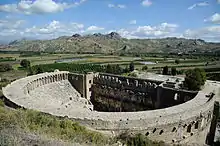
Yeşilçam is the sobriquet that refers to the Turkish film art and industry. The first movie exhibited in the Ottoman Empire was the Lumiere Brothers' 1895 film, L'Arrivée d'un train en gare de La Ciotat, which was shown in Istanbul in 1896. The first Turkish-made film was a documentary entitled Ayastefanos'taki Rus Abidesinin Yıkılışı (Demolition of the Russian Monument at San Stefano), directed by Fuat Uzkınay and completed in 1914. The first narrative film, Sedat Simavi's The Spy, was released in 1917. Turkey's first sound film was shown in 1931. Turkish directors like Metin Erksan, Nuri Bilge Ceylan, Yılmaz Güney, Zeki Demirkubuz and Ferzan Özpetek won numerous international awards such as the Palme d'Or and Golden Bear.[506][507]
Despite legal provisions, media freedom in Turkey has steadily deteriorated from 2010 onwards, with a precipitous decline following the failed coup attempt on 15 July 2016.[508] As of December 2016, at least 81 journalists were imprisoned in Turkey and more than 100 news outlets were closed.[248] Freedom House lists Turkey's media as not free.[509] The media crackdowns also extend to Internet censorship with Wikipedia getting blocked between 29 April 2017 and 15 January 2020.[510][511]
See also
- Index of Turkey-related articles
- Outline of Turkey
Notes
- Turkish President Recep Tayyip Erdogan has said "Our attitude on the Armenian issue has been clear from the beginning. We will never accept the accusations of genocide".[24] Scholars give several reasons for Turkey's position including the preservation of national identity, the demand for reparations and territorial concerns.[25]
References
- "Türkiye Cumhuriyeti Anayasası" (in Turkish). Grand National Assembly of Turkey. Archived from the original on 2 July 2020. Retrieved 1 July 2020.
3. Madde: Devletin Bütünlüğü, Resmi Dili, Bayrağı, Milli Marşı ve Başkenti: Türkiye Devleti, ülkesi ve milletiyle bölünmez bir bütündür. Dili Türkçedir. Bayrağı, şekli kanununda belirtilen, beyaz ay yıldızlı al bayraktır. Milli marşı "İstiklal Marşı" dır. Başkenti Ankara'dır.
{{cite news}}: CS1 maint: bot: original URL status unknown (link) - "Mevzuat: Anayasa" (in Turkish). Ankara: Constitutional Court of Turkey. Archived from the original on 21 June 2020. Retrieved 1 July 2020.
{{cite news}}: CS1 maint: bot: original URL status unknown (link) - Ethnologue: Ethnologue Languages of the World – Turkey, Retrieved 15 October 2017.
- "Turkey". The World Factbook. Central Intelligence Agency. Retrieved 13 October 2016.
- "Turkish Constitution". www.anayasa.gov.tr. Anayasa Mahkemesi. Retrieved 12 April 2022.
- "Surface water and surface water change". Organisation for Economic Co-operation and Development (OECD). Retrieved 11 October 2020.
- "Turkey-Turkiye". The World Factbook (2022 ed.). Central Intelligence Agency. Retrieved 21 October 2022.
- "The Results of Address Based Population Registration System, 2021". Turkish Statistical Institute. 4 February 2022. Retrieved 7 February 2022.
- "World Economic Outlook Database, October 2022". Imf. International Monetary Fund. Retrieved 11 October 2022.
- "Gini index (World Bank estimate) – Turkey". World Bank. 2019. Retrieved 15 November 2021.
- "Human Development Report 2021/2022" (PDF). United Nations Development Programme. 8 September 2022. Retrieved 8 September 2022.
- Howard, Douglas Arthur (2001). The History of Turkey. Greenwood Publishing Group. p. 43. ISBN 978-0-313-30708-9.
- Sharon R. Steadman; Gregory McMahon (2011). The Oxford Handbook of Ancient Anatolia: (10,000–323 BC). Oxford University Press. pp. 3–11, 37. ISBN 978-0-19-537614-2. Retrieved 23 March 2013.
- Casson, Lionel (1977). "The Thracians" (PDF). The Metropolitan Museum of Art Bulletin. 35 (1): 2–6. doi:10.2307/3258667. JSTOR 3258667. Archived from the original (PDF) on 3 May 2019. Retrieved 3 April 2013.
- Edwards, Iorwerth Eiddon Stephen (1977). The Cambridge Ancient History. Cambridge University Press. pp. 184, 787. ISBN 978-0-521-08691-2.
- David Noel Freedman; Allen C. Myers; Astrid Biles Beck (2000). Eerdmans Dictionary of the Bible. Wm. B. Eerdmans Publishing. p. 61. ISBN 978-0-8028-2400-4. Retrieved 24 March 2013.
- Mehmet Fuat Köprülü&Gary Leiser. The origins of the Ottoman Empire. p. 33.
- Masters, Bruce (2013). The Arabs of the Ottoman Empire, 1516–1918: A Social and Cultural History. Cambridge University Press. ISBN 978-1-107-03363-4.
- Somel, Selcuk Aksin (2010). The A to Z of the Ottoman Empire. Scarecrow Press. ISBN 978-1-4617-3176-4.
- Marushiakova, Elena; Popov, Veselin Zakhariev; Popov, Veselin; Descartes), Centre de recherches tsiganes (Université René (2001). Gypsies in the Ottoman Empire: A Contribution to the History of the Balkans. Univ of Hertfordshire Press. ISBN 978-1-902806-02-0.
- Roderic. H. Davison, Essays in Ottoman and Turkish History, 1774-1923 – The Impact of West, Texas 1990, pp. 115-116.
- Zürcher, Erik Jan (2004). Turkey: A Modern History. London: I. B. Tauris. pp. 93–5.
- Shaw and Shaw, Stanford J. and Ezel Kural (1977). History of The Ottoman Empire and Modern Turkey Vol. II. Cambridge: Cambridge University Press. pp. 274–9, 282–7.
- "Erdogan: Turkey will 'never accept' genocide charges". Deutsche Welle. Retrieved 7 February 2018.
- Tatz, Colin; Higgins, Winton (2016). The Magnitude of Genocide. ABC-CLIO. ISBN 978-1-4408-3161-4.
- Schaller, Dominik J.; Zimmerer, Jürgen (2008). "Late Ottoman genocides: the dissolution of the Ottoman Empire and Young Turkish population and extermination policies—introduction". Journal of Genocide Research. 10 (1): 7–14. doi:10.1080/14623520801950820. ISSN 1462-3528. S2CID 71515470.
- Roderic H. Davison; Review "From Paris to Sèvres: The Partition of the Ottoman Empire at the Peace Conference of 1919–1920" by Paul C. Helmreich in Slavic Review, Vol. 34, No. 1 (March 1975), pp. 186–187
- "From Rep. of Turkey Ministry of Foreign Affairs". Republic of Turkey Ministry of Foreign Affairs.
- "The Political Economy of Regional Power: Turkey" (PDF). giga-hamburg.de. Archived from the original (PDF) on 10 February 2014. Retrieved 18 February 2015.
- Michael J. Arlen (2006). Passage to Ararat. MacMillan. p. 159. ISBN 978-0-374-53012-9.
- "Turkey". Oxford English Dictionary (Online ed.). Oxford University Press. (Subscription or participating institution membership required.)
- Cevdet Küçük (1988–2016). "Türkiye". TDV Encyclopedia of Islam (44+2 vols.) (in Turkish). Istanbul: Turkiye Diyanet Foundation, Centre for Islamic Studies.
- Sylvain Auroux, E.F.K. Koerner, Hans-Josef Niederehe, Kees Versteegh (2000). History of the Language Sciences. p. 327.
{{cite book}}: CS1 maint: uses authors parameter (link) - Cemal Kafadar (2007). "A Rome of One's Own: Reflections on Cultural Geography and Identity in the Lands of Rum". Muqarnas. 24, History and Ideology: Architectural Heritage of the "Lands of Rum": 9.
- "Why Turkey is now 'Turkiye', and why that matters". TRT World. 13 December 2021. Retrieved 11 April 2022.
- "Exports to be labeled 'Made in Türkiye'". Hürriyet Daily News. 6 December 2021. Retrieved 11 April 2022.
- "Presidential Circular No. 2021/24 on the Use of the Term "Türkiye" as a Brand (in Turkish)" (PDF). Resmî Gazete. 4 December 2021. Retrieved 11 April 2022.
- Soylu, Ragip (17 January 2022). "Turkey to register its new name Türkiye to UN in coming weeks". Middle East Eye. Retrieved 11 April 2022.
- "UN to use 'Türkiye' instead of 'Turkey' after Ankara's request". TRT World. Retrieved 3 June 2022.
- "Turkey changes its name in rebranding bid". BBC News. 2 June 2022. Retrieved 2 June 2022.
- "The World's First Temple". Archaeology magazine. November–December 2008. p. 23.
- "The Position of Anatolian" (PDF). Archived from the original (PDF) on 2 March 2012. Retrieved 4 May 2013.
- Balter, Michael (27 February 2004). "Search for the Indo-Europeans: Were Kurgan horsemen or Anatolian farmers responsible for creating and spreading the world's most far-flung language family?". Science. 303 (5662): 1323. doi:10.1126/science.303.5662.1323. PMID 14988549. S2CID 28212584.
- "Çatalhöyük added to UNESCO World Heritage List". Global Heritage Fund. 3 July 2012. Archived from the original on 17 January 2013. Retrieved 9 February 2013.
- Chacon, Richard J.; Mendoza, Rubén G. (2017). Feast, Famine or Fighting?: Multiple Pathways to Social Complexity. Springer. p. 120. ISBN 9783319484020.
- "Troy". World History Encyclopedia. Retrieved 9 August 2014.
- "Ziyaret Tepe – Turkey Archaeological Dig Site". uakron.edu. Archived from the original on 3 March 2016. Retrieved 4 September 2010.
- "Assyrian Identity in Ancient Times And Today'" (PDF). Retrieved 4 September 2010.
- Zimansky, Paul. Urartian Material Culture As State Assemblage: An Anomaly in the Archaeology of Empire. p. 103.
- The Metropolitan Museum of Art, New York (October 2000). "Anatolia and the Caucasus, 2000–1000 B.C. in Timeline of Art History.". New York: The Metropolitan Museum of Art. Archived from the original on 10 September 2006. Retrieved 21 December 2006.
- Roux, Georges. Ancient Iraq. p. 314.
- Revelation 3:1–6
- Ramage, Andrew (2000). King Croesus' gold: Excavations at Sardis and the history of gold refining. Cambridge, Mass: Archaeological Exploration of Sardis, Harvard University Art Museums, in association with the British Museum Press. ISBN 978-0714108889.
- "Istanbul". britannica.com. Encyclopædia Britannica.
- Aristotle, Metaphysics Alpha, 983b18.
-
 Smith, William, ed. (1870). "Thales". Dictionary of Greek and Roman Biography and Mythology. p. 1016.
Smith, William, ed. (1870). "Thales". Dictionary of Greek and Roman Biography and Mythology. p. 1016.
- Michael Fowler, Early Greek Science: Thales to Plato, University of Virginia [Retrieved 16 June 2016]
- Frank N. Magill, The Ancient World: Dictionary of World Biography, Volume 1, Routledge, 2003 ISBN 1135457395
- Colony and Mother City in Ancient Greece By A. J. Graham page 98 “Judged by the number of its colonies Miletus was the most prolific of the Greek mother cities. For though some of the more extravagance claims made in antiquity have not been substantiated by modern investigations, her colonies were by far more numerous than those of any other Greek cities.”
- Diogenes of Sinope "The Zen of Disengagement: Diogene of Sinope". Voice in the Wilderness. Archived from the original on 17 October 2015.
- Centre, UNESCO World Heritage. "New Inscribed Properties". UNESCO World Heritage Centre.
- Mark Cartwright. "Celsus Library". World History Encyclopedia. Retrieved 2 February 2017.
- "The Temple of Artemis at Ephesus: The Un-Greek Temple and Wonder". World History Encyclopedia. Retrieved 17 February 2017.
- Wood (1985: 116–118)
- D.M. Lewis; John Boardman (1994). The Cambridge Ancient History. Cambridge University Press. p. 444. ISBN 978-0-521-23348-4. Retrieved 7 April 2013.
- Joseph Roisman, Ian Worthington. "A companion to Ancient Macedonia" John Wiley & Sons, 2011. ISBN 1-4443-5163-X pp. 135–138, 343
- Herodotus Book 8: Urania, 68 "...which have been fought near Euboea and have displayed deeds not inferior to those of others, speak to him thus:..."
- passages: 7.99, 8.68–69, 8.87–88, 8.93.2, 8.101–103
- Hooker, Richard (6 June 1999). "Ancient Greece: The Persian Wars". Washington State University, Washington, United States. Archived from the original on 3 December 2010. Retrieved 22 December 2006.
- The Metropolitan Museum of Art, New York (October 2000). "Anatolia and the Caucasus (Asia Minor), 1000 B.C. – 1 A.D. in Timeline of Art History.". New York: The Metropolitan Museum of Art. Archived from the original on 14 December 2006. Retrieved 21 December 2006.
- Theo van den Hout (2011). The Elements of Hittite. Cambridge University Press. p. 1. ISBN 978-1-139-50178-1. Retrieved 24 March 2013.
- Strobel, Karl (2013). "Central Anatolia". The Oxford Encyclopedia of the Bible and Archaeology. Oxford University Press. ISBN 978-0-19-984653-5. Retrieved 15 May 2018.
- Esler, Philip Francis (1998). Galatians. Routledge. p. 29. ISBN 978-0-415-11037-2.
Galatai was the Greek word used for the Celts from beyond the Rhine who invaded regions of Macedonia, Greece, Thrace and Asia Minor in the period 280–275 BCE
- See Diod.5.32-3; Just.26.2. Cf. Liv.38.17; Strabo 13.4.2.
- The Foreign Policy of Mithridates VI Eupator, King of Pontus, by B. C. McGing, p. 11
- Children of Achilles: The Greeks in Asia Minor Since the Days of Troy, by John Freely, p. 69–70
- Strabo of Amasia: A Greek Man of Letters in Augustan Rome, by Daniela Dueck, p. 3.
- McGing, Brian (2004). "Pontus". Encyclopaedia Iranica, online edition. Retrieved 14 November 2019.
- Bosworth, A. B.; Wheatley, P. V. (November 1998). "The origins of the Pontic house". The Journal of Hellenic Studies. 118: 155–164. doi:10.2307/632236. ISSN 2041-4099. JSTOR 632236. S2CID 162855144.
- "Hagia Sophia". Encyclopædia Britannica. Retrieved 2 February 2017.
- "Acts 11:26 and when he found him, he brought him back to Antioch. So for a full year they met together with the church and taught large numbers of people. The disciples were first called Christians at Antioch". biblehub.com. Retrieved 14 July 2021.
- Encyclopaedia Biblica, Vol. I, p. 186 (p. 125 of 612 in online .pdf file).
- "ANTIOCH - JewishEncyclopedia.com". jewishencyclopedia.com. Retrieved 14 July 2021.
- Acts 20:34
- Cross & Livingstone 2005, St Paul.
- Mark Golden (2011). "Mark Golden on Caroline Vout, Power and Eroticism" (PDF). The Ancient History Bulletin Online Reviews. 1: 64–66.
- Anthony Birley, Restless Emperor, pp. 164–7
- Daniel C. Waugh (2004). "Constantinople/Istanbul". University of Washington, Seattle, Washington. Retrieved 26 December 2006.
- Maas, Michael (2015). The Cambridge Companion to the Age of Attila. Cambridge University Press. ISBN 978-1-107-02175-4.
- Laiou & Morisson 2007, pp. 130–131; Pounds 1979, p. 124.
- Wink, Andre (1990). Al Hind: The Making of the Indo Islamic World, Vol. 1, Early Medieval India and the Expansion of Islam, 7th–11th Centuries. Brill Academic Publishers. p. 21. ISBN 978-90-04-09249-5.
- "The Seljuk Turks". peter.mackenzie.org. Retrieved 9 August 2014.
- Black, Jeremy (2005). The Atlas of World History. American Edition, New York: Covent Garden Books. pp. 65, 228. ISBN 9780756618612. This map varies from other maps which are slightly different in scope, especially along the Mediterranean and the Black Sea.
- Davison, Roderic H. (2013). Essays in Ottoman and Turkish History, 1774–1923: The Impact of the West. University of Texas Press. pp. 3–5. ISBN 978-0-292-75894-0.
- Katherine Swynford Lambton, Ann; Lewis, Bernard, eds. (1977). The Cambridge history of Islam (Reprint. ed.). Cambridge [u.a.]: Cambridge Univ. Press. p. 233. ISBN 978-0-521-29135-4.
- Craig S. Davis. "The Middle East For Dummies" ISBN 0-7645-5483-2 p. 66
- Thomas Spencer Baynes. "The Encyclopædia Britannica: Latest Edition. A Dictionary of Arts, Sciences and General Literature, Volume 23". Werner, 1902
- Emine Fetvacı. "Picturing History at the Ottoman Court" p 18
- Simons, Marlise (22 August 1993). "Center of Ottoman Power". The New York Times. Retrieved 4 June 2009.
- "Dolmabahce Palace". dolmabahcepalace.com. Retrieved 4 August 2014.
- Faroqhi, Suraiya (1994). "Crisis and Change, 1590–1699". In İnalcık, Halil; Donald Quataert (eds.). An Economic and Social History of the Ottoman Empire, 1300–1914. Vol. 2. Cambridge University Press. p. 507. ISBN 978-0-521-57456-3.
- Stanford J. Shaw (1976). History of the Ottoman Empire and Modern Turkey. Vol. 1. Cambridge University Press. p. 213. ISBN 978-0-521-29163-7. Retrieved 15 June 2013.
- Kirk, George E. (2008). A Short History of the Middle East. Brill Academic Publishers. p. 58. ISBN 978-1-4437-2568-2.
- Palabiyik, Hamit, Turkish Public Administration: From Tradition to the Modern Age, (Ankara, 2008), 84.
- Ismail Hakki Goksoy. Ottoman-Aceh Relations According to the Turkish Sources (PDF). Archived from the original (PDF) on 19 January 2008. Retrieved 7 December 2018.
- Charles A. Truxillo (2012), Jain Publishing Company, "Crusaders in the Far East: The Moro Wars in the Philippines in the Context of the Ibero-Islamic World War".
- "Ottoman/Turkish Visions of the Nation, 1860–1950". Retrieved 18 February 2015.
- Niall Ferguson (2 January 2008). "An Ottoman warning for indebted America". Financial Times. Retrieved 5 September 2016.
- Todorova, Maria (2009). Imagining the Balkans. Oxford University Press. p. 175. ISBN 978-0-19-972838-1. Retrieved 15 June 2013.
- Mann, Michael (2005). The Dark Side of Democracy: Explaining Ethnic Cleansing. Cambridge University Press. p. 118. ISBN 978-0-521-53854-1. Retrieved 28 February 2013.
- "Collapse of the Ottoman Empire, 1918–1920". nzhistory.net.nz. Retrieved 9 August 2014.
- Isa Blumi (2013). Ottoman Refugees, 1878–1939: Migration in a Post-Imperial World. Bloomsbury Academic. ISBN 978-1-4725-1536-0.
- "Armenian Genocide". Encyclopædia Britannica. Retrieved 23 April 2015.
- "Fact Sheet: Armenian Genocide". University of Michigan. Archived from the original on 18 August 2010. Retrieved 15 July 2010.
- Freedman, Jeri (2009). The Armenian genocide (1st ed.). New York: Rosen Pub. Group. ISBN 978-1-4042-1825-3.
- Totten, Samuel, Paul Robert Bartrop, Steven L. Jacobs (eds.) Dictionary of Genocide. Greenwood Publishing Group, 2008, p. 19. ISBN 0-313-34642-9.
- Raziye Akkoç (15 October 2015). "ECHR: Why Turkey won't talk about the Armenian genocide". The Daily Telegraph. Archived from the original on 10 January 2022. Retrieved 28 May 2016.
- Donald Bloxham (2005). The Great Game of Genocide: Imperialism, Nationalism, And the Destruction of the Ottoman Armenians. Oxford University Press. p. 150. ISBN 978-0-19-927356-0. Retrieved 9 February 2013.
- Levene, Mark (Winter 1998). "Creating a Modern 'Zone of Genocide': The Impact of Nation- and State-Formation on Eastern Anatolia, 1878–1923". Holocaust and Genocide Studies. 12 (3): 393–433. doi:10.1093/hgs/12.3.393.
- Ferguson, Niall (2007). The War of the World: Twentieth-Century Conflict and the Descent of the West. Penguin Group. p. 180. ISBN 978-0-14-311239-6.
- "The Treaty of Sèvres, 1920". Harold B. Library, Brigham Young University.
- Mango, Andrew (2000). Atatürk: The Biography of the Founder of Modern Turkey. Overlook. p. lxxviii. ISBN 978-1-58567-011-6.
- Heper, Criss, Metin, Nur Bilge (2009). Historical Dictionary of Turkey. Scarecrow Press. ISBN 978-0-8108-6281-4.
- Axiarlis, Evangelia (2014). Political Islam and the Secular State in Turkey: Democracy, Reform and the Justice and Development Party. I.B. Tauris. p. 11.
- Clogg, Richard (2002). A Concise History of Greece. Cambridge University Press. p. 101. ISBN 978-0-521-00479-4. Retrieved 9 February 2013.
- "Turkey holds first election that allows women to vote". OUPblog. 6 February 2012.
- Gerhard Bowering; Patricia Crone; Wadad Kadi; Devin J. Stewart; Muhammad Qasim Zaman; Mahan Mirza (2012). The Princeton Encyclopedia of Islamic Political Thought. Princeton University Press. p. 49. ISBN 978-1-4008-3855-4. Retrieved 14 August 2013.
Following the revolution, Mustafa Kemal became an important figure in the military ranks of the Ottoman Committee of Union and Progress (CUP) as a protégé ... Although the sultanate had already been abolished in November 1922, the republic was founded in October 1923. ... ambitious reform programme aimed at the creation of a modern, secular state and the construction of a new identity for its citizens.
- League of Nations Treaty Series, vol. 173, pp. 214–241.
- Hassan, Mona (10 January 2017). Longing for the Lost Caliphate: A Transregional History. Princeton University Press. ISBN 978-1-4008-8371-4.
- Soner Çağaptay (2002). "Reconfiguring the Turkish nation in the 1930s". Nationalism and Ethnic Politics. Yale University. 8 (2): 67–82. doi:10.1080/13537110208428662. S2CID 143855822.
- "Growth in United Nations membership (1945–2005)". United Nations. 3 July 2006. Archived from the original on 17 January 2016. Retrieved 30 October 2006.
- "Members and partners". OECD. Retrieved 9 August 2014.
- Hale, William Mathew (1994). Turkish Politics and the Military. Routledge. pp. 161, 215, 246. ISBN 978-0-415-02455-6.
- Arsu, Sebsem (12 April 2012). "Turkish Military Leaders Held for Role in '97 Coup". The New York Times. Retrieved 11 August 2014.
- Uslu, Nasuh (2003). The Cyprus question as an issue of Turkish foreign policy and Turkish-American relations, 1959–2003. Nova Publishers. p. 119. ISBN 978-1-59033-847-6. Retrieved 16 August 2011.
- "Timeline: Cyprus". BBC. 12 December 2006. Retrieved 25 December 2006.
- "UN Cyprus Talks". United Nations. Retrieved 1 February 2017.
- "U.S. Department of State – Bureau of Counterterrorism: Foreign Terrorist Organizations". U.S. Department of State. Retrieved 18 April 2020.
- "Council of the European Union: Council Decision (CFSP) 2019/1341 of 8 August 2019 updating the list of persons, groups and entities subject to Articles 2, 3 and 4 of Common Position 2001/931/CFSP on the application of specific measures to combat terrorism". Official Journal of the European Union. Retrieved 18 April 2020.
- Timeline: Kurdish militant group PKK's three-decade war with Turkey, Reuters, 21 March 2013
- "Turkish forces kill 32 Kurdish militants in bloody weekend as conflict escalates". The Guardian. Reuters. 10 January 2016.
- "Turkey's PKK peace plan delayed". BBC. 10 November 2009. Retrieved 6 February 2010.
- "Ocalan sentenced to death". BBC. 29 June 1999.
- "Turkey lifts Ocalan death sentence". BBC. 3 October 2002.
- Nas, Tevfik F. (1992). Economics and Politics of Turkish Liberalization. Lehigh University Press. p. 12. ISBN 978-0-934223-19-5.
- "Chronology of Turkey-EU relations". Turkish Secretariat of European Union Affairs. Archived from the original on 15 May 2007. Retrieved 30 October 2006.
- "Interview with European Commission President Jose Manuel Barroso on BBC Sunday AM" (PDF). European Commission. 15 October 2006. Archived (PDF) from the original on 21 November 2006. Retrieved 17 December 2006.
- "European Parliament votes to suspend Turkey's EU membership bid". www.dw.com. Deutsche Welle. 13 March 2019.
- Mullen, Jethro; Cullinane, Susannah (4 June 2013). "What's driving unrest and protests in Turkey?". CNN. Retrieved 6 June 2013.
- Cunningham, Erin; Sly, Liz; Karatas, Zeynep (16 July 2016). "Turkey rounds up thousands of suspected participants in coup attempt". The Washington Post. Retrieved 17 July 2016.
- Hansen, Suzy (13 April 2017). "Inside Turkey's Purge". The New York Times. Retrieved 6 May 2017.
- "Turkey Purge". turkeypurge.com. Retrieved 6 May 2017.
- "Turkish court orders release of journalists during their trial". Reuters. 9 March 2018. Retrieved 24 October 2022.
- "Pence heads to Turkey as Erdogan rejects calls for ceasefire in Syria". Deutsche Welle. 16 October 2019.
- "Full Text: Memorandum of Understanding between Turkey and Russia on northern Syria". The Defense Post. 22 October 2019.
- "Turkey not resuming military operation in northeast Syria: security source". Reuters. 25 November 2019 – via www.reuters.com.
- "General Structure of Turkish Public Administration" (PDF). justice.gov.tr/. Ministry of Justice. Archived from the original (PDF) on 21 March 2015. Retrieved 14 August 2014.
- "Ministry of Internal Affairs: Administrative Units in Turkey". Retrieved 17 April 2020.
- "CIA World Factbook: Turkey". Cia.gov. Archived from the original on 10 January 2021. Retrieved 29 August 2011.
- "Turkey: Government". globaledge.msu.edu. Retrieved 11 April 2022.
- "Duties and Powers". global.tbmm.gov.tr. The Grand National Assembly of Turkey. Retrieved 12 April 2022.
- "Duties and Powers". www.tccb.gov.tr. Presidency Of The Republic Of Turkey. Retrieved 11 April 2022.
- "Law on Constitutional Court". www.anayasa.gov.tr. Retrieved 12 April 2022.
- "Turkish women celebrate 85th anniversary of suffrage". Hürriyet Daily News. 5 December 2019. Retrieved 12 April 2022.
- "Euro court backs Turkey Islamist ban". BBC. 31 July 2001. Retrieved 14 December 2006.
- "Turkey's Kurd party ban criticised". BBC. 14 March 2003. Retrieved 14 December 2006.
- "AK Party, MHP announce draft for Turkey's new election law". Daily Sabah. 14 March 2022. Retrieved 22 March 2022.
- Yılmaz, Hakan. "Conservatism in Turkey" (PDF). European Stability Initiative. Retrieved 12 April 2022.
- Kate Fleet; Suraiya Faroqhi; Reşat Kasaba (2008). The Cambridge History of Turkey. Cambridge University Press. pp. 357–358. ISBN 978-0-521-62096-3. Retrieved 13 June 2013.
- "Past Elections". Yüksek Seçim Kurulu. Retrieved 12 April 2022.
- Tarman, Z. Derya (2012). "Turkey". In Smits, Jan M. (ed.). Elgar Encyclopedia of Comparative Law (2nd ed.). Edward Elgar. p. 940. ISBN 978-1849804158.
- Tarman, Z. Derya (2012). "Turkey". In Smits, Jan M. (ed.). Elgar Encyclopedia of Comparative Law (2nd ed.). Edward Elgar. p. 941. ISBN 978-1849804158.
- "The Judicial System of Turkey" (PDF). uhdigm.adalet.gov.tr/. Ministry of Justice. Archived from the original (PDF) on 3 March 2016. Retrieved 14 August 2014.
- "European Commission: Turkey 2015 report" (PDF). European Commission. 10 November 2015. Archived from the original (PDF) on 18 August 2016. Retrieved 6 July 2016.
- "European Parliament resolution of 14 April 2016 on the 2015 report on Turkey". European Parliament. 14 April 2016. Retrieved 6 July 2016.
- "Turkey's institutions are failing to comply with good governance principles and combat corruption". Transparency International. 7 April 2016. Retrieved 6 July 2016.
- "As ISIS attacks mount, Turkey steps up its war on free speech". Newsweek. 6 July 2016. Retrieved 6 July 2016.
- "The United Nations Organization and Turkey". mfa.gov.tr. Archived from the original on 15 July 2014. Retrieved 12 June 2014.
- "Turkey's Relations with the Organisation for Economic Co-operation and Development (OECD)". mfa.gov.tr. Archived from the original on 15 July 2014. Retrieved 12 June 2014.
- "The Republic of Turkey and The Organization of The Islamic Conference". mfa.gov.tr. Archived from the original on 14 July 2014. Retrieved 12 June 2014.
- "The Organization for Security and Co-operation in Europe (OSCE)". mfa.gov.tr. Archived from the original on 15 July 2014. Retrieved 12 June 2014.
- "Turkey's relations with the Economic Cooperation Organization (ECO)". mfa.gov.tr. Archived from the original on 16 May 2014. Retrieved 12 June 2014.
- "The Black Sea Economic Cooperation Organization (BSEC)". mfa.gov.tr. Archived from the original on 15 July 2014. Retrieved 12 June 2014.
- "D8". mfa.gov.tr. Archived from the original on 15 July 2014. Retrieved 12 June 2014.
- "G-20". mfa.gov.tr. Archived from the original on 15 July 2014. Retrieved 12 June 2014.
- "Türkiye'nin üyeliği kabul edildi". Hürriyet Daily News. 17 October 2008. Retrieved 1 November 2010.
- "SCO accepts Afghanistan as observer, Turkey dialogue partner". Xinhua. 7 June 2012. Retrieved 7 June 2012.
- "No: 253, 26 September 2013, Press Release on Turkey's Membership to the Asia Cooperation Dialogue". Ministry of Foreign Affairs of Turkey. 26 September 2013. Retrieved 26 October 2013.
- Mardell, Mark (11 December 2006). "Turkey's EU membership bid stalls". BBC. Retrieved 17 December 2006.
- Koplow, Michael J. (20 February 2014). "False Friends. Why the United States Is Getting Tough With Turkey". Foreign Affairs. Retrieved 6 April 2015.
- "Turkey: Background and U.S. Relations" (PDF). fas.org. Retrieved 6 April 2015.
- Huston, James A. (1988). Outposts and Allies: U.S. Army Logistics in the Cold War, 1945–1953. Susquehanna University Press. p. 134. ISBN 978-0-941664-84-4.
- Ziya Öniş, ŞuhnazYılmaz. "Turkey-EU-US Triangle in Perspective: Transformation or Continuity?" (PDF). istanbul2004.ku.edu.tr/. Archived from the original (PDF) on 16 March 2014. Retrieved 4 August 2014.
- Mitrovic, Marija (24 March 2014). Turkish Foreign Policy towards the Balkans (PDF). edoc.hu-berlin.de. Humboldt-Universität zu Berlin, Philosophische Fakultät III, Institut für Sozialwissenschaften. doi:10.18452/3090. Retrieved 9 August 2014.
- "Turkey's Relations with NATO". mfa.gov.tr. Archived from the original on 22 October 2014. Retrieved 12 June 2014.
- İdris Bal (2004). Turkish Foreign Policy in Post Cold War Era. Universal-Publishers. p. 269. ISBN 978-1-58112-423-1. Retrieved 15 June 2013.
- Elanchenny, Susae (2010). Breaking the Ice The Role of Civil Society and Media in Turkey-Armenia Relations An Evaluation of the 'Dialogue-Building between Turkey and Armenia' Project. Istanbul: Istanbul Kültür University. p. 9. ISBN 978-605-4233-80-9.
- "Turkey, Armenia hold 2nd diplomatic talks aimed at normalization". Daily Sabah. March 2022. Retrieved 22 March 2022.
- Taşpınar, Ömer (September 2008). "Turkey's Middle East Policies: Between Neo-Ottomanism and Kemalism". Carnegie Endowment for International Peace. Retrieved 5 June 2010.
- Murinson, Alexander (2009). Turkey's Entente with Israel and Azerbaijan: State Identity and Security in the Middle East and Caucasus (Routledge Studies in Middle Eastern Politics). Routledge. p. 119. ISBN 978-0-415-77892-3.
- "Syria ratchets up tension with Turkey – warning it of dangers of rebel support". Euronews. 4 October 2013. Archived from the original on 4 March 2016. Retrieved 18 October 2013.
- "Turkey, Egypt recall envoys in wake of violence". Bloomberg. 16 August 2013. Archived from the original on 28 September 2013.
- Yaşar Yakış (29 September 2014). "On Relations between Turkey and Egypt". Turkish Weekly. Archived from the original on 5 October 2014. Retrieved 19 November 2014.
- "Israel and Turkey end rift over Gaza flotilla killings". BBC News. BBC. 27 June 2016. Retrieved 27 June 2016.
- "Greece, Egypt, Cyprus urge Turkey to quit gas search off island". Reuters. 29 October 2014. Retrieved 19 November 2014.
- "Egypt, Greece, Cyprus pledge to boost energy cooperation". Reuters. 8 November 2014. Retrieved 19 November 2014.
- "Policy of Zero Problems with our Neighbors". Turkish Ministry of Foreign Affairs. Archived from the original on 22 October 2014. Retrieved 19 November 2014.
- Piotr Zalewsky (22 August 2013). "How Turkey Went From 'Zero Problems' to Zero Friends". Foreign Policy. Retrieved 19 November 2014.
- Mark Lowen (20 November 2014). "Erdogan's 'New Turkey' drifts towards isolation". BBC News. BBC. Retrieved 22 November 2014.
- Gareth Porter (28 May 2015). "Gulf allies and 'Army of Conquest'". Al-Ahram Weekly. Archived from the original on 19 September 2015. Retrieved 13 October 2015.
- "Syria conflict: Turkey and Russia 'agree ceasefire plan'". BBC News. BBC. 28 December 2016.
- "Turkey and Russia agree on draft Syria ceasefire, report says". CNN. 28 December 2016.
- "How Russia and Turkey brokered peace in Syria – and sidelined the US". CNN. 30 December 2016.
- "Kurdish fighters join Turkey's Afrin operation". Al-Monitor. 16 February 2018.
- "Recep Tayyip Erdogan vows to 'drown' Syrian Kurdish force set up by US". The Independent. 15 January 2018.
- "Turkey to U.S.: End support for Syrian Kurd YPG or risk confrontation". Reuters. 25 January 2018.
- "Cyprus: EU 'appeasement' of Turkey in exploration row will go nowhere". Reuters. 17 August 2020.
- "Turkey threatens Greece over disputed Mediterranean territorial claims". Deutsche Welle. 5 September 2020.
- Turkish General Staff (2006). "Turkish Armed Forces Defense Organization". Turkish Armed Forces. Archived from the original on 18 February 2009. Retrieved 15 December 2006.
- United Nations High Commissioner for Refugees (UNHCR), Directorate for Movements of Persons, Migration and Consular Affairs – Asylum and Migration Division (July 2001). "Turkey/Military service" (PDF). UNHCR. Archived from the original (PDF) on 22 November 2006. Retrieved 27 December 2006.
{{cite web}}: CS1 maint: multiple names: authors list (link) - "EBCO: European Bureau for Conscientious Objection". Ebco-beoc.eu. Retrieved 4 September 2010.
- The International Institute for Strategic Studies (February 2022). The Military Balance 2022. London: Routledge. ISBN 978-1-032-27900-8. ISSN 0459-7222.
- "Der Spiegel: Foreign Minister Wants US Nukes out of Germany (10 April 2009)". Der Spiegel. 30 March 2009. Retrieved 1 November 2010.
- Hans M. Kristensen. "NRDC: U.S. Nuclear Weapons in Europe" (PDF). Natural Resources Defense Council, 2005. Archived from the original (PDF) on 1 January 2011. Retrieved 1 November 2010.
- "Enter the EU Battle Groups" (PDF). Chaillot Paper no.97. European Union Institute for Security Studies. February 2007. p. 88. Archived from the original (PDF) on 4 March 2016. Retrieved 18 February 2012.
- "Contribution of Turkish Armed Forces to Peace Support Operations". tsk.tr. Turkish Armed Forces. Archived from the original on 19 February 2015. Retrieved 3 August 2014.
- "Turkey finalizes military training base in Somalia". hurriyetdailynews.com. Retrieved 5 April 2017.
- "Turkey trains Kurdish peshmerga forces in fight against Islamic State". Reuters. 22 November 2014. Retrieved 5 April 2017.
- "Mapping the Turkish Military's Expanding Footprint". Bloomberg. 7 March 2019. Retrieved 17 March 2022.
- Larrabee, F. Stephen; Lesser, Ian O. (2003). Turkish foreign policy in an age of uncertainty. Santa Monica: Rand Corporation. pp. 94. ISBN 978-0-8330-3404-5.
albania.
- "What is Turkey doing in Iraq?". Hürriyet Daily News. 8 October 2016.
- "Seeing shared threats, Turkey sets up military base in Qatar". Reuters. 28 April 2016.
- "Turkey to open its largest military base in Somalia". TRT World. 30 September 2017.
- Richmond, Oliver P. (1998). Mediating in Cyprus: The Cypriot Communities and the United Nations. Psychology Press. p. 260. ISBN 978-0-7146-4877-4. Retrieved 9 February 2013.
- "European Court of Human Rights: Turkey Ranks First in Violations in between 1959–2011". Bianet – Bagimsiz Iletisim Agi. Retrieved 29 December 2015.
- The European Court of Human Rights (2015). Annual report, 2014 (PDF) (Report). Strasbourg: Registry of the European Court. ISBN 978-92-871-9919-5. Retrieved 29 December 2015.
- "Human rights in Turkey: still a long way to go to meet accession criteria". European Parliament Human Rights committee. 26 October 2010. Archived from the original on 15 June 2011. Retrieved 9 February 2013.
- Zürcher, Erik J. (2004). Turkey A Modern History, Revised Edition. I.B.Tauris. p. 263. ISBN 978-1-85043-399-6.
- "Who are Kurdistan Workers' Party (PKK) rebels?". bbc.com. BBC. 4 November 2016.
- Bilgin, Fevzi; Sarihan, Ali, eds. (2013). Understanding Turkey's Kurdish Question. Lexington Books. p. 90. ISBN 978-0-7391-8403-5.
- Balci, Ali (2016). The PKK-Kurdistan Workers' Party's Regional Politics: During and After the Cold War. Springer. p. 96. ISBN 978-3-319-42219-0.
- White, Paul (2015). The PKK: Coming Down from the Mountains. Zed Books Ltd. ISBN 978-1-78360-040-3. Retrieved 24 July 2017.
- Stanton, Jessica A. (2016). Violence and Restraint in Civil War: Civilian Targeting in the Shadow of International Law. Cambridge University Press. p. 217. ISBN 978-1-107-06910-7. Retrieved 24 July 2017.
- France-Presse, Agence (2 February 2016). "Turkish lecturer to be put on trial for posing exam question on PKK leader". The Guardian. Retrieved 24 July 2017.
- "Ever closer to independence". The Economist. Retrieved 24 July 2017.
- "İşte TBMM'nin 'dokunulmazlık' tablosu: 1980'den bu yana 44 vekillik düştü". 2000. Retrieved 19 October 2022.
- Turkey's Press Freedom Crisis. "Turkey's Press Freedom Crisis". Committee to Protect Journalists. Retrieved 9 February 2013.
- "Turkey's crackdown propels number of journalists in jail worldwide to record high". cpj.org. Retrieved 17 January 2017.
- "Russia, China and Turkey top yearly list of music freedom violations". https://cpj.org. Retrieved 15 October 2022.
{{cite web}}: External link in|website= - "Russia, China and Turkey top yearly list of music freedom violations" (PDF). freemuse.org. Retrieved 15 September 2022.
- "Turkey's sharp-tongued rapper faces five years in jail". Al Monitor. Retrieved 15 October 2022.
- "17TH İSTANBUL LGBTI+ PRIDE PARADE: Police Attack with Shields, Pepper Gas After Pride Parade Statement Read". Bianet - Bagimsiz Iletisim Agi.
- Tehmina Kazi (7 October 2011). "The Ottoman empire's secular history undermines sharia claims". The Guardian. Retrieved 23 August 2015.
- "islam and homosexuality". 11 November 2015. Archived from the original on 25 October 2015. Retrieved 2 November 2015.
- Birch, Nicholas (19 July 2008). "Was Ahmet Yildiz the victim of Turkey's first gay honour killing?". Independent. London. Retrieved 8 May 2021.
- "İstanbul Valiliği: Onur yürüyüşüne izin verilmeyecek". BBC News Türkçe (in Turkish). 17 June 2016. Retrieved 8 May 2021.
- "Onur Yürüyüşü'nde 20 gözaltı". www.gazeteduvar.com.tr (in Turkish). 22 June 2019. Retrieved 8 May 2021.
- "Ankara Valiliği'nden LGBT etkinliklerine yasak". BBC News Türkçe (in Turkish). 19 November 2017. Retrieved 8 May 2021.
- "Almost half of people in Turkey think that LGBT+ people should have equal rights, nine percent more than last year, according to a survey". Retrieved 11 May 2010.
- "Perceptions of Gender Equality". Retrieved 11 May 2010.
- "Of 23 Countries Surveyed, Majority (65%) in 20 Countries Support Legal Recognition of Same-Sex Unions". Ipsos. 29 March 2015. Archived from the original on 3 June 2015.
- "Turkey's LGBT community draws hope from Harvey Milk". Al Monitor. 17 June 2016. Retrieved 27 January 2022.
- Metz, Helen Chapin, ed. (1996). "Geography". Turkey: A Country Study. Area handbook series (fifth ed.). Washington, DC: US GPO for the Federal Research Division of the Library of Congress. ISBN 978-0-8444-0864-4. LCCN 95049612.
- "UN Demographic Yearbook" (PDF). Retrieved 1 November 2010.
- US Library of Congress. "Geography of Turkey". US Library of Congress. Retrieved 13 December 2006.
- "Geography of Turkey". Turkish Ministry of Tourism. 2005. Retrieved 13 December 2006.
- Scheffel, Richard L.; Wernet, Susan J., eds. (1980). Natural Wonders of the World. United States of America: Reader's Digest Association, Inc. p. 286. ISBN 978-0-89577-087-5.
- "Hierapolis-Pamukkale World Heritage Site". UNESCO World Heritage Centre. Retrieved 17 January 2022.
- "Armenian Highland – Historic Region". Encyclopedia Britannica. Retrieved 28 November 2018.
Armenian Highland, mountainous region of western Asia. It lies mainly in Turkey, occupies all of Armenia, and includes southern Georgia, western Azerbaijan, and northwestern Iran.
- "Mount Ararat". britannica.com. Retrieved 18 February 2015.
- "Lake Van". britannica.com. Retrieved 18 February 2015.
- "Biodiversity in Turkey". 6 May 2012. Archived from the original on 7 April 2016. Retrieved 9 August 2014.
- "Turkey's flora and fauna". allaboutturkey.com. Retrieved 12 June 2014.
- Couzens, Dominic (2008). Top 100 Birding Sites of the World. University of California Press. pp. 73–75. ISBN 978-0-520-25932-4.
- "Pontic Mountains and highlands". Archived from the original on 26 February 2014. Retrieved 9 August 2014.
- Blunt, Wilfrid. Tulipomania. p. 7.
- E.S. Forster (trans. et ed.), The Turkish Letters of Ogier Ghiselin de Busbecq (Oxford, 1927).
- "Statistics". milliparklar.gov.tr. Ministry of Forest and Water – General Directorare of Nature Conservation and National Parks. Archived from the original on 17 December 2015. Retrieved 12 June 2014.
- Kazancı, Nizamettin; Kuzucuoğlu, Catherine (2019), Kuzucuoğlu, Catherine; Çiner, Attila; Kazancı, Nizamettin (eds.), "Threats and Conservation of Landscapes in Turkey", Landscapes and Landforms of Turkey, World Geomorphological Landscapes, Springer International Publishing, pp. 603–632, doi:10.1007/978-3-030-03515-0_36, ISBN 978-3-030-03515-0, S2CID 134498356
- Can, O.E. (2004). Status, conservation and management of large carnivores in Turkey. Convention on the Conservation of European Wildlife and Natural Habitats. Standing Committee, 24th meeting, 29 November-3 December 2004, Strasbourg.
- "Diyarbakır'da öldürülen leopar İran Parsı çıktı". Archived from the original on 23 October 2016. Retrieved 21 July 2015.
- Üstay, A.H. (1990). Hunting in Turkey. BBA, Istanbul.
- "Specific Animals of Turkey". gateofturkey.com. Retrieved 12 June 2014.
- "Climate of Turkey" (PDF). General Directorate of Meteorology. Archived from the original (PDF) on 28 March 2014. Retrieved 24 January 2014.
- "People at risk of poverty or social exclusion". ec.europa.eu. Eurostat. Retrieved 27 December 2020.
- "Unemployment, total (% of total labor force) (national estimate) – Turkey | Data". data.worldbank.org. Retrieved 14 April 2021.
- "New World Bank Report Looks at Turkey's Rise to the Threshold of High-Income Status and the Challenges Remaining". World Bank. 10 December 2014. Retrieved 14 April 2021.
- "International Reserves and Foreign Currency Liquidity". tcmb.gov.tr. Central Bank of the Republic of Turkey. Retrieved 31 October 2021.
- "The Fate of Turkey's Battered Lira Hangs With Local Investors". bloomberg.com. Bloomberg. 14 October 2021.
- "Turkish lira falls out of favour with local investors again". aljazeera.com. Al Jazeera. 14 October 2021.
- Bartolomiej Kaminski; Francis Ng (1 May 2006). "Turkey's evolving trade integration into Pan-European markets" (PDF). World Bank. p. 3. Archived from the original (PDF) on 14 June 2007. Retrieved 27 December 2006.
- "2021 Statistics | www.oica.net". www.oica.net. Retrieved 26 August 2022.
- "The Shipbuilding Industry in Turkey" (PDF). OECD. September 2011.
- "About Best-Selling Home Appliance Brand Beko UK". Retrieved 9 August 2014.
- "Beko Avrupa'da üçüncülüğe oynuyor". Retrieved 9 August 2014.
- "The Unknown TV Giant – Businessweek". Bloomberg.com. 9 June 2006. Retrieved 9 August 2014.
- Turkish Statistical Institute (27 February 2006). "The result of Income Distribution". Turkish Statistical Institute. Archived from the original on 14 October 2006. Retrieved 11 December 2006.
- "Foreign direct investment, net inflows (BoP, current US$) – Turkey". The World Bank. Retrieved 10 August 2021.
- "How to ruin a country's economy: AKP's 15 year long order of plunder and depredation in Turkey". BirGün. 6 December 2016. Retrieved 7 December 2016.
- "WIND VS COAL POWER IN TURKEY/SOLAR PV VS COAL IN TURKEY" (PDF). Carbon Tracker. 2020.
- Ambrose, Jillian (12 March 2020). "Coronavirus poses threat to climate action, says watchdog". The Guardian. ISSN 0261-3077. Retrieved 13 March 2020.
- Acar, Sevil; Challe, Sarah; Christopoulos, Stamatios; Christo, Giovanna (2018). "Fossil fuel subsidies as a lose-lose: Fiscal and environmental burdens in Turkey". New Perspectives on Turkey. 58: 93–124. doi:10.1017/npt.2018.7. S2CID 149594404.
- "Energy pricing and non-market flows in Turkey's energy sector" (PDF). SHURA Energy Transition Center. Archived from the original (PDF) on 30 December 2019. Retrieved 18 March 2020.
- "Big nations aid fossil fuels more than clean energies amid pandemic, researchers find". Climate Home News. 3 July 2020. Retrieved 7 July 2020.
- "The external cost of fossil fuel use in power generation, heating and road transport in Turkey • SHURA Enerji Dönüşümü Merkezi". SHURA Enerji Dönüşümü Merkezi. Archived from the original on 23 April 2021. Retrieved 9 February 2021.
- "The EBRD's just transition initiative". European Bank for Reconstruction and Development.
- "Why Turkey is becoming the Silicon Valley of mobile gaming". Digiday. 26 January 2022.
- "Turkey's fastest unicorn Dream Games' valuation hits $2.75B". DailySabah. 18 January 2022.
- "Turkish mobile gaming start-up defies economic turmoil to hit a $2.75 billion valuation". CNBC. 18 January 2022.
- "Tourism Statistics" (PDF). Culture and tourism Ministry. Archived from the original (PDF) on 11 April 2019. Retrieved 27 March 2019.
- UNWTO Tourism Highlights: 2019 Edition | World Tourism Organization. 2019. doi:10.18111/9789284421152. ISBN 978-92-844-2115-2. S2CID 240665765.
- "Blue Flag sites". Blue Flag.
- "Top 100 City Destinations: 2019 Edition". Euromonitor International. Retrieved 3 December 2019.
- "Antalya hosts over 9 million tourists in 2021". Hürriyet. Retrieved 22 January 2022.
- "Construction - İGA". igairport.com. Archived from the original on 1 April 2019. Retrieved 6 April 2019.
- "CIA World Factbook: Turkey". Archived from the original on 10 January 2021. Retrieved 17 November 2014.
- "Study in Turkey: International Airports in Turkey". Archived from the original on 25 December 2013. Retrieved 17 November 2014.
- "It will be the biggest airport of the world". 24 January 2013. Archived from the original on 29 January 2013. Retrieved 24 January 2013.
- "Istanbul's New Erdoğan-Backed Airport to Be Named After... Erdoğan". Newsweek. 14 August 2014.
- "Network" (PDF). Investor.turkishairlines.com. Retrieved 26 September 2017.
- "Turkish Airlines' net profit triples in 9-month". Anadolu Agency. 7 November 2018. Archived from the original on 9 November 2018. Retrieved 9 November 2018.
- Cebeci, Uğur (21 August 2019). "Yeni uçuşlar yakında". www.hurriyet.com.tr (in Turkish). Archived from the original on 23 August 2019. Retrieved 23 August 2019.
- "Yol Ağı Bilgileri". Karayolları Genel Müdürlüğü. Archived from the original on 9 November 2016. Retrieved 9 August 2014.
- Infrastrukturprojekte sollen die türkische Bauwirtschaft ankurbeln Archived 10 February 2013 at archive.today, Germany Trade and Invest, 24. November 2009
- "Dünyada Ve Türkıyede Hizli Tren". hizlitren.tcdd.gov.tr. Archived from the original on 5 July 2014. Retrieved 12 August 2014.
- "Istanbul's $1.3BN Eurasia Tunnel prepares to open". Anadolu Agency. 19 December 2016.
- "Istanbul Metro Passenger Statistics" (PDF). Istanbul Metro (in Turkish). 6 January 2020. Retrieved 16 January 2020.
- "Lines in Operation" [Rail Systems]. Metro İstanbul. 2022. Retrieved 9 January 2022.
- "Velaro Turkey: High-Speed Train for TCDD" (PDF). Siemens Mobility. Retrieved 30 April 2020.
- "Groundbreaking ceremony for bridge over Dardanelles to take place on March 18". Hürriyet Daily News. 17 March 2017. Retrieved 19 March 2017.
- "Serbia receives first gas from TurkStream pipeline".
- "BAKÜ-T İ FL İ S-CEYHAN BORUHATTI'NDA SON DURUM" (PDF). emreozgur.com. Retrieved 12 August 2014.
- OECD (2019), section 1.
- "Energy pricing and non-market flows in Turkey's energy sector • SHURA Enerji Dönüşümü Merkezi". SHURA Enerji Dönüşümü Merkezi. Archived from the original on 6 August 2020. Retrieved 18 May 2020.
- Lund, J.W.; Freeston, D.H.; Boyd, T.L. (2005). "Direct application of geothermal energy: 2005 Worldwide review" (PDF). Geothermics. 34 (6): 691–727. doi:10.1016/j.geothermics.2005.09.003.
- "Renewable Electricity Capacity And Generation Statistics June 20". Retrieved 2 December 2021.
- "Who We Are? The Scientific And Technological Research Council of Turkey". Tubitak.gov. Retrieved 9 August 2014.
- "Türkiye Bilimler Akademisi". Tuba.gov. Archived from the original on 21 February 2014. Retrieved 9 August 2014.
- "Turkish Atomic Energy Authority – Mission of TAEK". TAEK. Archived from the original on 8 June 2014. Retrieved 9 August 2014.
- "Welcome to the site of Akkuyu NPP JSC!". Akkuyu NGS location. Akkuyu NGS A.Ş., akkunpp.com. Retrieved 2 October 2012.
- "Cheap but lethal Turkish drones bolster Ukraine's defenses". MSN. Retrieved 17 March 2022.
- Gatopoulos, Alex. "The Nagorno-Karabakh conflict is ushering in a new age of warfare". www.aljazeera.com. Retrieved 17 March 2022.
- "Space Launch System Project". Undersecretariat for Defence Industries. Archived from the original on 20 December 2013. Retrieved 20 December 2013.
- Bekdil, Burak Ege (28 July 2013). "Turkey's Sat-Launcher Plans Raise Concerns". Defense News. Archived from the original on 30 August 2013. Retrieved 20 December 2013.
- Bekdil, Burak Ege (12 December 2013). "Turkey Spends Big on Innovation". Defense News. Archived from the original on 20 December 2013. Retrieved 20 December 2013.
- Agencies, Daily Sabah with (7 October 2015). "Turkish professor, Aziz Sancar, part of the team that wins Nobel Chemistry Prize". Daily Sabah.
- "TURKEY" (PDF). Global Innovation Index. World Intellectual Property Organization. 2021. Retrieved 15 December 2021.
- "Birth Statistics, 2021". data.tuik.gov.tr. 18 May 2021.
- Edgecomb, Diane; Ahmed, Mohammed M.A.; Özel, Çeto (2007). A fire in my heart: Kurdish tales. Westport, CT: Libraries Unlimited. p. xv. ISBN 978-1-59158-437-7.
The outlines of the map of Kurdistan were taken from two sources: first, a map produced by the CIA in 1992 depicting areas with a Kurdish majority [...]
- "The Results of Address Based Population Registration System, 2011". Turkish Statistical Institute. Retrieved 15 February 2012.
- Turkish Statistical Institute (2010). "Population statistics in 2009". Turkish Statistical Institute. Retrieved 28 January 2010.
- Bayir, Derya (22 April 2016). Minorities and Nationalism in Turkish Law. Routledge. pp. 144–145. ISBN 978-1-317-09579-8.
- "Toplumsal Yapı Araştırması 2006" (PDF). KONDA Research and Consultancy. 2006. Archived from the original (PDF) on 15 February 2017. Retrieved 21 February 2015.
- Mutlu, Servet (1996). "Ethnic Kurds in Turkey: A Demographic Study". International Journal of Middle East Studies. 28 (4): 517–541. doi:10.1017/S0020743800063819. S2CID 154212694.
- Extra, Guus; Gorter, Durk (2001). The other languages of Europe: Demographic, Sociolinguistic and Educational Perspectives. Multilingual Matters. ISBN 978-1-85359-509-7.
- Migdal, Joel S. (2004). Boundaries and Belonging: States and Societies in the Struggle to Shape Identities and Local Practices. Cambridge University Press. ISBN 978-1-139-45236-6.
- Kirisci, Kemal; Winrow, Gareth M. (5 November 2013). The Kurdish Question and Turkey: An Example of a Trans-state Ethnic Conflict. Routledge. ISBN 978-1-135-21770-9.
- Aktürk, Şener (12 November 2012). Regimes of Ethnicity and Nationhood in Germany, Russia, and Turkey. Cambridge University Press. ISBN 978-1-139-85169-5.
- Watts, Nicole F. (2010). Activists in Office: Kurdish Politics and Protest in Turkey (Studies in Modernity and National Identity). Seattle: University of Washington Press. p. 167. ISBN 978-0-295-99050-7.
- Amikam Nachmani (2003). Turkey: Facing a New Millenniium : Coping With Intertwined Conflicts. Manchester University Press. pp. 90–. ISBN 978-0-7190-6370-1. Retrieved 5 May 2013.
- Jaipaul L. Roopnarine (2015). Fathers Across Cultures: The Importance, Roles, and Diverse Practices of Dads: The Importance, Roles, and Diverse Practices of Dads. ABC-CLIO. p. 328. ISBN 978-1-4408-3232-1.
Kurds are the largest ethnic minority group (about 20%), and Armenians, Greeks, Sephardic Jews,...
- Richard M. Medina; George F. Hepner (2013). The Geography of International Terrorism: An Introduction to Spaces and Places of Violent Non-State Groups. CRC Press. p. 113. ISBN 978-1-4398-8688-5.
Turkey has numerous non-Turkish ethnic groups of which the Kurds are the largest, comprising approximately 20% of the population.
- al-Shamahi, Abubakr. "Turkey's ethnic make-up: A complex melting pot". alaraby. Archived from the original on 7 November 2017. Retrieved 3 November 2017.
- "The Ethnic Groups Of Turkey". WorldAtlas. 18 July 2019.
- Kahl, Thede (2006). "The Islamisation of the Meglen Vlachs (Megleno-Romanians): The Village of Nânti (Nótia) and the "Nântinets" in Present-Day Turkey". Nationalities Papers. 34 (1): 71–90. doi:10.1080/00905990500504871. S2CID 161615853.
- Luke Coffey (18 February 2016). "Turkey's demographic challenge". www.aljazeera.com.
- "Syria Regional Refugee Response: Turkey". unhcr.org. Retrieved 21 April 2020.
- "Turkey faces interlinked quagmires in Idlib and Libya". Ahval. 19 May 2020. Archived from the original on 28 June 2020. Retrieved 25 June 2020.
- "Exclusive: 2,000 Syrian fighters deployed to Libya to support government". The Guardian. 15 January 2020.
- "Trends in International Migrant Stock: The 2013 Revision". esa.un.org. United Nations. Retrieved 14 August 2014.
- "Total Persons of Concern by Country of Asylum". data2. UNHCR. Retrieved 24 September 2018.
- Katzner, Kenneth (2002). Languages of the World, Third Edition. Routledge. ISBN 978-0-415-25004-7.
- "Turkey Overview". minorityrights.org. Archived from the original on 9 September 2015.
- "Türkiye'nin yüzde 85'i 'anadilim Türkçe' diyor". Milliyet.com.tr. Retrieved 4 November 2012.
- "Interactive Atlas of the World's Languages in Danger". UNESCO. Retrieved 9 August 2014.
- Kiuiper, Kathleen (2009). Islamic Art, Literature, and Culture. Rosen Education Service. pp. 201. ISBN 978-1-61530-019-8.
- UNESCO World Heritage Centre (27 June 2011). "Six new sites inscribed on UNESCO's World Heritage List". Retrieved 17 August 2021.
{{cite web}}: CS1 maint: url-status (link) - Axel Tschentscher. "International Constitutional Law: Turkey Constitution". Servat.unibe.ch. Retrieved 1 November 2010.
- "Turkey: Islam and Laicism Between the Interests of State, Politics, and Society" (PDF). Peace Research Institute Frankfurt. Archived from the original (PDF) on 28 October 2008. Retrieved 19 October 2008.
- "Religion, Ipsos Global Trends". Ipsos. 2017. Archived from the original on 5 September 2017.
- "KONDA Toplumsal Değişim Raporu: Türkiye'de inançsızlık yükselişte". euronews (in Turkish). 3 January 2019. Retrieved 4 August 2020.
- "Hayat Tarzı - 10 Yılda Ne Değişti?". interaktif.konda.com.tr. Retrieved 4 August 2020.
- "Gezici Araştırma Merkezi Başkanı Murat Gezici SÖZCÜ'ye açıkladı: Türkiye'nin kaderi Z kuşağının elinde". www.sozcu.com.tr.
- "Gezici Araştırma Merkezi Başkanı Murat Gezici: Türkiye'nin kaderi Z kuşağının elinde". www.gercekgundem.com.
- "WVS Database". www.worldvaluessurvey.org. Retrieved 6 August 2022.
- "KONDA Toplumsal Değişim Raporu: Türkiye'de inançsızlık yükselişte". euronews (in Turkish). 3 January 2019. Retrieved 13 August 2020.
- "Konda | Araştırma ve Danışmanlık". konda.com.tr. Retrieved 13 August 2020.
- "WHAT HAS CHANGED IN 10 YEARS?". interaktif.konda.com.tr. Retrieved 14 August 2020.
- "Middle East :: Turkey — The World Factbook – Central Intelligence Agency". www.cia.gov. 26 October 2021. Archived from the original on 10 January 2021.
- "TURKEY" (PDF). Library of Congress: Federal Research Division. Retrieved 27 March 2019.
- "Turkey: International Religious Freedom Report 2007". State.gov. 14 September 2007. Retrieved 9 August 2011.
- "World Directory of Minorities and Indigenous Peoples – Turkey : Alevis". refworld.org. Retrieved 22 April 2015.
- "Caferi İmamlar" (in Turkish). Aksiyon.com.tr. 11 October 2004. Archived from the original on 17 March 2011. Retrieved 4 September 2010.
- Parry, Ken (2009). Christianity: Religions of the World. Infobase Publishing. p. 139. ISBN 9781438106397.
- Parry, Ken (2010). The Blackwell Companion to Eastern Christianity. John Wiley & Sons. p. 368. ISBN 9781444333619.
- İçduygu, Ahmet; Toktaş, Şule; Ali Soner, B. (1 February 2008). "The politics of population in a nation-building process: Emigration of non-Muslims from Turkey". Ethnic and Racial Studies. 31 (2): 358–389. doi:10.1080/01419870701491937. S2CID 143541451.
- Chapter The refugees question in Greece (1821–1930) in "Θέματα Νεοελληνικής Ιστορίας", ΟΕΔΒ ("Topics from Modern Greek History"). 8th edition (PDF), Nikolaos Andriotis, 2008
- Quarterly, Middle East (2001). "Editors' Introduction: Why a Special Issue?: Disappearing Christians of the Middle East" (PDF). Middle East Quarterly. Retrieved 11 June 2013.
- "Religious Composition by Country, 2010–2050". Pew Research Center. 2 April 2015. Archived from the original on 15 June 2020. Retrieved 13 May 2020.
- "Religions". Central Intelligence Agency. Archived from the original on 16 March 2017. Retrieved 9 February 2013.
- "Statistics by Country". catholic-hierarchy.org. Retrieved 18 February 2015.
- "Christen in der islamischen Welt – Aus Politik und Zeitgeschichte" (PDF). 2008. Retrieved 11 June 2013.
- "Turkish Protestants still face "long path" to religious freedom". christiancentury.org. Retrieved 3 November 2014.
- "Statistics and Church Facts | Total Church Membership". newsroom.churchofjesuschrist.org. Retrieved 24 August 2021.
- "Türkiye'de Hristiyan ve Yahudilere ait 439 ibadethane ve 24 dernek var". Independent Türkçe.
- "Turkish Jews – Brief History". science.co.il. Retrieved 11 August 2014.
- "An Overview of the History of the Jews in Turkey" (PDF). American Sephardi Federation. 2006. Archived from the original on 6 October 2013. Retrieved 11 June 2013.
{{cite web}}: CS1 maint: unfit URL (link) - "Jewish Population of the World". www.jewishvirtuallibrary.org. Retrieved 22 October 2019.
- DellaPergola, Sergio (2018). "World Jewish Population, 2018" (PDF). In Dashefsky, Arnold; Sheskin, Ira M. (eds.). The American Jewish Year Book, 2018. American Jewish Year Book. Vol. 118. Dordrecht: Springer. pp. 361–452. ISBN 9783030039066.
- Ekin Karaca (3 March 2016). "Being an Atheist in Turkey". www.human.nl. Archived from the original on 1 July 2016. Retrieved 24 June 2016.
- "Beyond the Straight Path: Obstacles and Progress for Atheism in Turkey". blogs.lse.ac.uk. 24 November 2015. Retrieved 2 April 2017.
- "The first Atheist Association in Turkey is founded". turkishatheist.net. Retrieved 2 April 2017.
- Akyol, Mustafa (16 April 2018). "Why so many Turks are losing faith in Islam". Al-Monitor. Retrieved 21 April 2018.
- "Atheism grows in Turkey as Recep Tayyip Erdogan urges Islam | DW | 09.01.2019". Deutsche Welle.
- "The number of atheists increasing in Turkey". asianews.it.
- "The young Turks rejecting Islam". BBC News. 9 May 2018.
- "World Oldest Universities". Archived from the original on 15 January 2008.
- "Education in Turkey". World Education Services. Retrieved 12 June 2013.
- "Turkey's Education Reform Bill Is About Playing Politics With Pedagogy". The New York Times. 23 March 2012. Retrieved 12 June 2013.
- "Turkey's Education Reform Bill Is About Playing Politics With Pedagogy". Turkish Higher Education System. 23 January 2022. Retrieved 23 January 2013.
- "Improving The Quality And Equity of Basic Education in Turkey Challenges And Options" (PDF). World Bank. 30 June 2011. p. viii. Archived from the original (PDF) on 16 October 2013. Retrieved 12 June 2013.
- "Cumhurbaşkanı Erdoğan: Eğer samimiysen gel anayasa değişikliğini yapalım". Retrieved 10 October 2022.
- "Guide for Foreign Students planning Education in Turkey". Archived from the original on 12 July 2018. Retrieved 9 August 2014.
- "World University Rankings 2012–2013". Times Higher Education. Retrieved 16 June 2013.
- Mustafa Akyol (7 November 2016). "Turkish universities latest domino in Erdogan's path". Al-Monitor.
- "History". istanbul.edu.tr. Retrieved 12 June 2014.
- "ErasmusFacts, Figures & Trends" (PDF). 30 January 2022.
- "Find your ESN section". Erasmus Student Network.
- "Türkiye'deki yabancı öğrenci sayısı 795 bin 962'ye ulaştı". Retrieved 5 January 2022.
- "Turkey offers huge opportunities for foreign students". Retrieved 5 January 2022.
- "TÜRKİYE SCHOLARSHIPS-TÜRKİYE FOR EDUCATION" (PDF). Retrieved 30 August 2013.
- "Türkiye Scholarships-FAQ". Retrieved 30 August 2013.
- "Scholarships". Turkey Scholarship. Retrieved 7 January 2019.
- Atun, Rifat (1 October 2020). "Transforming Turkey's Health System". The New England Journal of Medicine. 373 (14).
- "Türkiye'nin nüfusu (2020) belli oldu". www.sozcu.com.tr (in Turkish). Retrieved 4 August 2020.
- Ciccone, John (13 December 2021). "Current Health Care System Cannot Survive Aging Population". Psychiatric Times. Vol 38, Issue 12. Retrieved 1 January 2022.
- "WHO Mean Body Mass Index (BMI)". World Health Organization. Retrieved 5 February 2019.
- Akyuz, Ezgi; Samavati, Mehrdad; Kaynak, Burcak (14 August 2020). "Spatial distribution of health risks associated with PM2.5 in Turkey and Iran using satellite and ground observations". Atmospheric Pollution Research. 11 (12): 2350–2360. doi:10.1016/j.apr.2020.08.011. ISSN 1309-1042. S2CID 225477420.
- "Health tourism earns above $1B to Turkey in 2019, under spotlight with COVID-19". Daily Sabah. Daily Sabah. 20 August 2020. Retrieved 8 April 2021.
- Ibrahim Kaya (2004). Social Theory and Later Modernities: The Turkish Experience. Liverpool University Press. pp. 57–58. ISBN 978-0-85323-898-0. Retrieved 12 June 2013.
- Erhan Solmaz (2021). "How a Country Turkey? Cultural and Sociological Situation in Turkey". Simit Çay. Retrieved 14 January 2021.
- Royal Academy of Arts (2005). "Turks – A Journey of a Thousand Years: 600–1600". Royal Academy of Arts. Archived from the original on 18 February 2007. Retrieved 12 December 2006.
- Barry, Michael (2004). Figurative art in medieval Islam and the riddle of Bihzâd of Herât (1465–1535). p. 27. ISBN 978-2-08-030421-6. Retrieved 11 February 2017.
- "Turkish Miniatures". www.turkishculture.org. Retrieved 11 February 2017.
- Antoinette Harri; Allison Ohta (1999). 10th International Congress of Turkish Art. Fondation Max Van Berchem. ISBN 978-2-05-101763-3.
The first military training institutions were the Imperial Army Engineering School (Mühendishane-i Berr-i Hümâyun, 1793) and the Imperial School of Military Sciences (Mekteb-i Ulûm-ı Harbiye-i Şahane, 1834). Both schools taught painting to enable cadets to produce topographic layouts and technical drawings to illustrate landscapes ...
- ""10'Lar' Grubu", "Yenı Dal Grubu", "Sıyah Kalem Grubu"". turkresmi.com. Archived from the original on 8 September 2006. Retrieved 11 August 2014.
- Brueggemann, Werner; Boehmer, Harald (1982). Teppiche der Bauern und Nomaden in Anatolien = Carpets of the Peasants and Nomads in Anatolia (1st ed.). Munich: Verlag Kunst und Antiquitäten. pp. 34–39. ISBN 978-3-921811-20-7.
- Figurative Art in Medieval Islam, Michael Barry, p. 27
- "The Turkish Art of Marbling (EBRU)". turkishculture.org. Retrieved 11 February 2017.
- Gábor Ágoston; Bruce Alan Masters (2009). Encyclopedia of the Ottoman Empire. Infobase Publishing. p. 48. ISBN 978-1-4381-1025-7.
- Stanford J. Shaw; Ezel Kural Shaw (1977). History of the Ottoman Empire and Modern Turkey. Vol. 2. Cambridge University Press. pp. 260–261. ISBN 978-0-521-29166-8.
- "Ottoman Music". turkishculture.org. Retrieved 18 February 2015.
- "Pamuk wins Nobel Literature prize". BBC. 12 October 2006. Retrieved 12 December 2006.
- "Traditional Theatre". turkishculture.org. Retrieved 11 February 2017.
- Jon Pareles (20 December 2009). "Crossing Generations and Borders: A Turkish Pop Diva's Musical Tour". The New York Times.
- Stokes, Martin (2000). Sounds of Anatolia. Penguin Books. ISBN 978-1-85828-636-5., pp. 396–410.
- "History of music in Turkey". Les Arts Turcs. 1 May 1999.
- İlyasoğlu (1998), 14.
- "Turkish Folk Dances". ncturkishfestival. Archived from the original on 12 March 2009. Retrieved 29 May 2014.
- "Seljuk architecture", Illustrated Dictionary of Historic Architecture, ed. Cyril M. Harris, (Dover Publications, 1977), 485.
- Voyce, Arthur (1957). "National Elements in Russian Architecture". Journal of the Society of Architectural Historians. 16 (2): 6–16. doi:10.2307/987741. ISSN 0037-9808. JSTOR 987741.
- Simons, Marlise (22 August 1993). "Center of Ottoman Power". The New York Times. Retrieved 4 June 2009.
- "A list of the buildings designed by Mimar Sinan". Retrieved 9 August 2014.
- Goodwin, Godfrey (2003). A History of Ottoman Architecture. Thames & Hudson. ISBN 978-0-500-27429-3.
- "Turkish Architecture in the Republican Period". archmuseum.org. Archived from the original on 18 March 2015. Retrieved 18 February 2015.
- "Tayyare Apartment Building". AtelyeMim.com. Archived from the original on 17 June 2013. Retrieved 2 February 2012.
- Yaşar, Ahmet (2014). Emecen, Feridun M.; Gürkan Yüzyış, Emrah Safa (eds.). İstanbul Hanları: 18. Yüzyıl Sonu ve 19. Yüzyıl Başı [Inns of Istanbul: End of 18th Century and Beginning of 19th Century]. Uluslararası Osmanlı İstanbulu Sempozyumu bildirileri, 29 Mayıs-1 Haziran 2013 (in Turkish). Yıldız Teknik Üniversitesi-Fen Bilimleri Enstitüsü. pp. 511–524. Retrieved 27 February 2013.
- "Ankara – State Museum of Painting and Sculpture". Republic of Turkey, Ministry of Culture. Archived from the original on 3 February 2012. Retrieved 2 February 2012.
- "Ankara: Ethnographical Museum". Republic of Turkey, Ministry of Culture. Archived from the original on 14 January 2017. Retrieved 2 February 2012.
- "Ankara – T.C. Ziraat Bankası Müzesi". kvmgm.ktb.gov.tr.
- "Türkiye İş Bankası BİNASI". envanter.gov.tr. Archived from the original on 18 February 2015. Retrieved 18 February 2015.
- "Bebek Mosque". ArchNet.org. Archived from the original on 3 January 2014. Retrieved 2 February 2012.
- "Kemer Hatun Mosque, Beyoglu, Istanbul" (in Turkish). MimarlikMuzesi.org. Archived from the original on 21 July 2012. Retrieved 2 February 2012.
- "Mass Housing Development by a Government Agency and the Politics of Urbanization" (PDF). 14th International Planning History Conference submission by Nilüfer Baturayoğlu Yöney and Yıldız Salman, Istanbul Technical University Faculty of Architecture, Turkey. Archived from the original (PDF) on 31 March 2022. Retrieved 2 February 2012.
- "Turkish coffee culture and tradition". UNESCO. 5 December 2013. Retrieved 18 August 2014.
- Çakır Morin, Arzu (5 December 2013). "Türk kahvesi Unesco korumasında". Hürriyet (in Turkish). Istanbul. Retrieved 18 August 2014.
- İlkin, Nur; Kaufman, Sheilah (2002). A Taste of Turkish cuisine. Hippocrene Books. ISBN 978-0781809481. Retrieved 12 December 2017.
- Aarssen, Jeroen; Backus, Ad (2000). Colloquial Turkish. Routledge. p. 71. ISBN 978-0-415-15746-9. Retrieved 15 April 2009.
- Claflin, Kyri W.; Scholliers, Peter (2013). Writing Food History: A Global Perspective. Berg. ISBN 978-0-85785-217-5.
- Kia, Mehrdad (2017). The Ottoman Empire: A Historical Encyclopedia [2 volumes]. ABC-CLIO. ISBN 978-1-61069-389-9.
- "Food in Turkey – Turkish Food, Turkish Cuisine". foodbycountry.com. Retrieved 12 August 2014.
- Burak Sansal (2006). "Sports in Turkey". allaboutturkey.com. Retrieved 13 December 2006.
- "Galatasaray AŞ". uefa.com. Retrieved 10 August 2014.
- "Historical Achievements". tff.org. Retrieved 10 August 2014.
- "Historic achievements of the Efes Pilsen Basketball Team". Anadolu Efes Spor Kulübü. Archived from the original on 3 May 2008. Retrieved 9 February 2013.
- "Anadolu Efes S.K.: Our successes". Archived from the original on 24 March 2012. Retrieved 9 August 2014.
- "2012 Year in Review: EuroChallenge". fibaeurope.com. Retrieved 10 August 2014.
- "Galatasaray Lift EuroLeague Women Title". fibaeurope.com. Retrieved 10 August 2014.
- "Our International Achievements". fenerbahce.org.tr. Archived from the original on 12 August 2014. Retrieved 10 August 2014.
- "Women's Volleyball". eczacibasisporkulubu.org.tr. Retrieved 10 August 2014.
- "Turkish volleyball teams' successes in Europe". hurriyet.com.tr. Retrieved 10 August 2014.
- "Vakıfbank women claim volleyball Champions League trophy". Hürriyet Daily News. Retrieved 10 June 2018.
- "National Team's Activities". tvf.org.tr. Archived from the original on 29 August 2014. Retrieved 10 August 2014.
- Burak Sansal (2006). "Oiled Wrestling". allaboutturkey.com. Retrieved 13 December 2006.
- "Historical Kırkpınar oil wrestling festival kicks off in northwestern Turkey". Daily Sabah. 13 July 2018.
- "Kırkpınar Oiled Wrestling Tournament: History". Kirkpinar.com. 21 April 2007. Archived from the original on 1 August 2008. Retrieved 1 November 2010.
- Gegner, Christiane. "FILA Wrestling Database". Iat.uni-leipzig.de. Archived from the original on 13 March 2009. Retrieved 1 November 2010.
- "TRT World". www.trtworld.com.
- "The Political Economy of the Media in Turkey: A Sectoral Analysis" (PDF). tesev.org.tr. Archived from the original (PDF) on 16 July 2012. Retrieved 18 February 2015.
- Turkey country profile. Library of Congress Federal Research Division (January 2006). This article incorporates text from this source, which is in the public domain.
- "About RTÜK". The Radio and Television Supreme Council (RTÜK). Archived from the original on 6 August 2020. Retrieved 18 April 2020.
- "Gazete Tirajları 02.05.2016 – 08.05.2016". Gazeteciler.com. Archived from the original on 19 December 2015. Retrieved 1 August 2016.
- Jenna Krajeski (30 March 2012). "Turkey: Soap Operas and Politics". Pulitzer Center. Archived from the original on 17 January 2013. Retrieved 15 January 2013.
- "Turkish Dramas Sweep Latin America". International Business Times. 9 February 2016. Retrieved 1 October 2016.
- "Turkey world"s second highest TV series exporter after US – Business". Hürriyet Daily News. Retrieved 14 October 2017.
- "TURKISH CINEMA". www.turkishculture.org. Retrieved 11 February 2017.
- "Berlinale 1964: Prize Winners". berlinale.de. Archived from the original on 19 March 2015. Retrieved 20 February 2010.
- "CPJ testifies on Turkey's press freedom record after failed coup attempt". Committee to Protect Journalists. 14 September 2016. Retrieved 16 December 2016.
- "Turkey". freedomhouse.org. Retrieved 29 January 2015.
- Kingsley, Patrick (30 April 2017). "Turkey Purges 4,000 More Officials, and Blocks Wikipedia". The New York Times. Retrieved 1 May 2017.
- "Turkey blocks Wikipedia under law designed to protect national security". The Guardian. 29 April 2017. Retrieved 1 May 2017.
Further reading
- Mango, Andrew (2004). The Turks Today. Overlook. ISBN 978-1-58567-615-6.
- Pope, Hugh; Pope, Nicole (2004). Turkey Unveiled. Overlook. ISBN 978-1-58567-581-4.
- Reed, Fred A. (1999). Anatolia Junction: a Journey into Hidden Turkey. Burnaby, BC: Talonbooks [sic]. 320 p., ill. with b&w photos. ISBN 0-88922-426-9
- Revolinski, Kevin (2006). The Yogurt Man Cometh: Tales of an American Teacher in Turkey. Çitlembik. ISBN 978-9944-424-01-1.
- Roxburgh, David J. (ed.) (2005). Turks: A Journey of a Thousand Years, 600–1600. Royal Academy of Arts. ISBN 1-903973-56-2.
- Laiou, Angeliki E.; Morisson, Cécile (2007). The Byzantine Economy. Cambridge, England: Cambridge University Press. ISBN 978-0-521-84978-4..
- Pounds, Norman John Greville (1979). An Historical Geography of Europe, 1500–1840. Cambridge, England: Cambridge University Press. ISBN 978-0-521-22379-9..
External links
- General
- turkey.com – Topical multilingual website about Turkey.
- Turkey from UCB Libraries GovPubs
- Data on Turkey from OECD
- Turkey at Curlie
 Geographic data related to Turkey at OpenStreetMap
Geographic data related to Turkey at OpenStreetMap
- Tourism
 Wikimedia Atlas of Turkey
Wikimedia Atlas of Turkey- Go Türkiye – Turkey's Official Tourism Portal
- Official website of the Ministry of Culture and Tourism
- Government
- Official website of the Presidency of the Republic of Turkey
- Official website of the Grand National Assembly of Turkey Archived 23 January 2015 at the Wayback Machine
- Economy




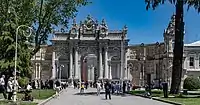
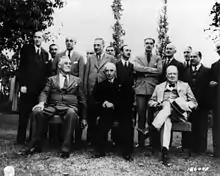
.jpg.webp)
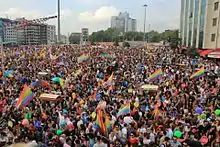
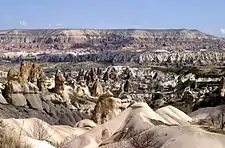
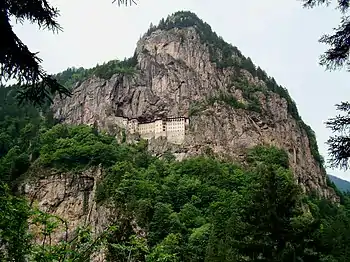

.png.webp)
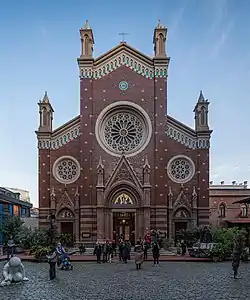
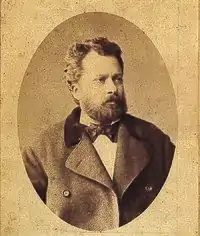

.svg.png.webp)
.svg.png.webp)

